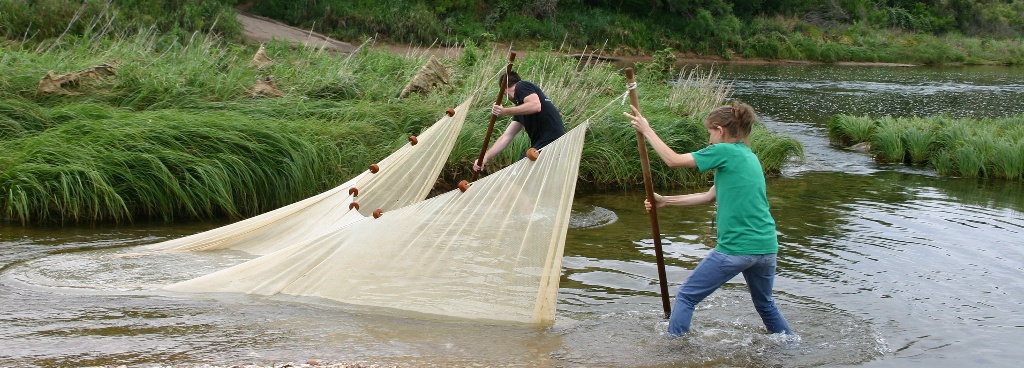
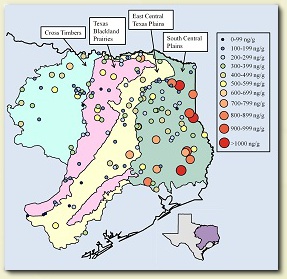
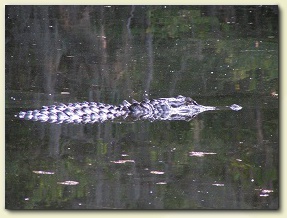








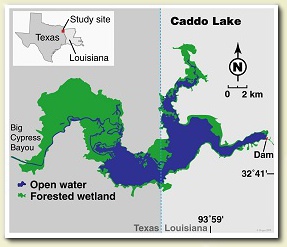

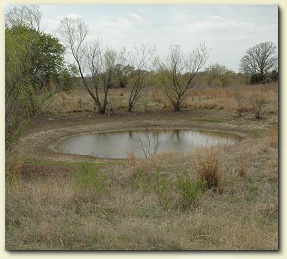

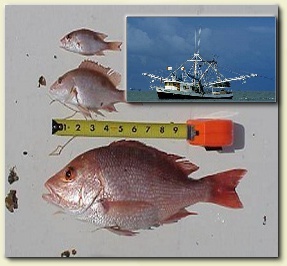
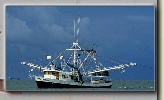


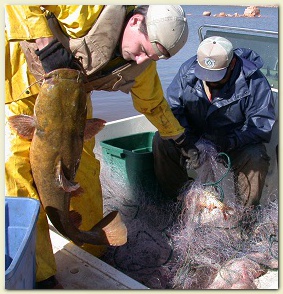
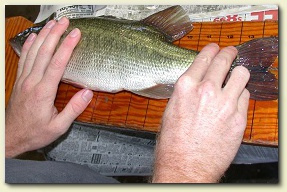

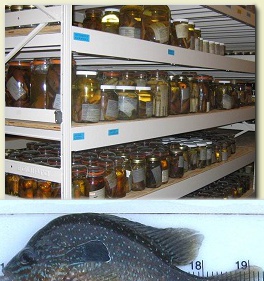
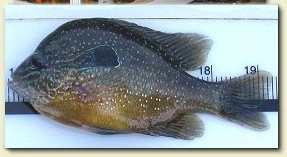

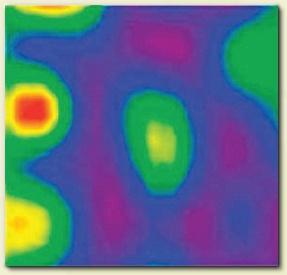






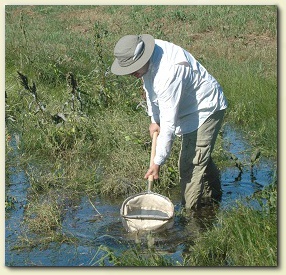
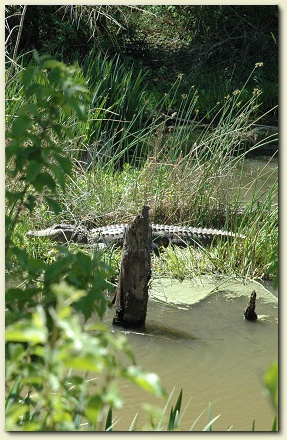


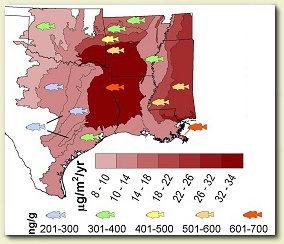


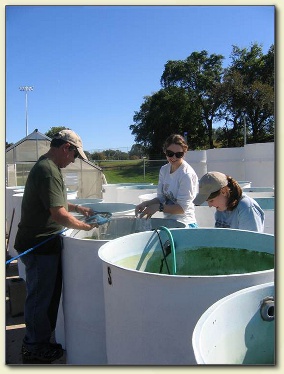

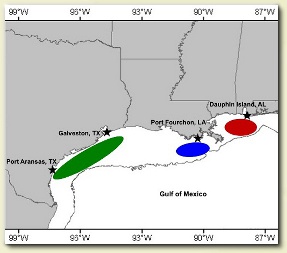

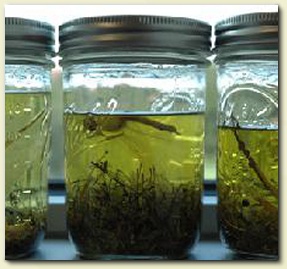

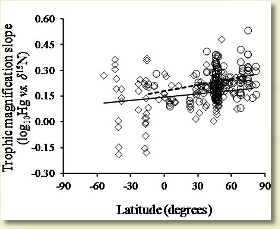


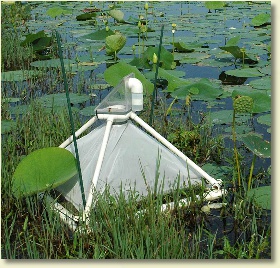
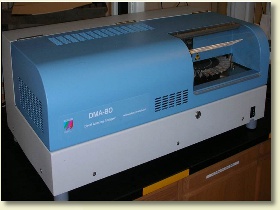


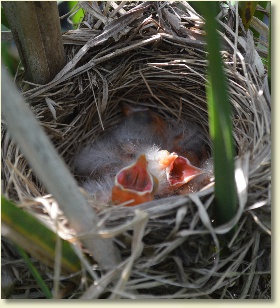

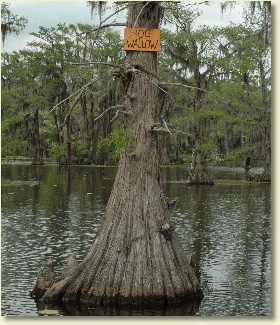

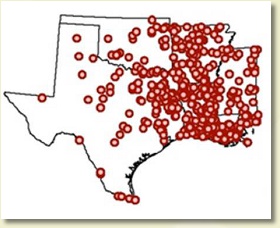
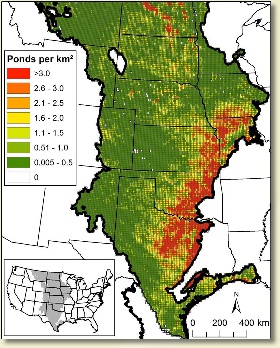



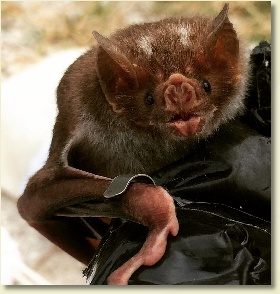
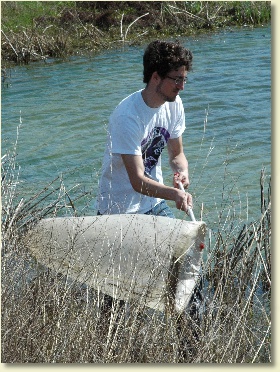
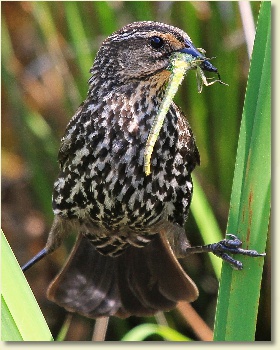








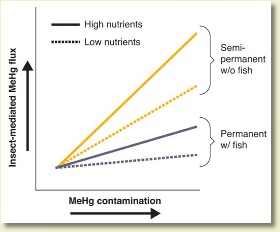
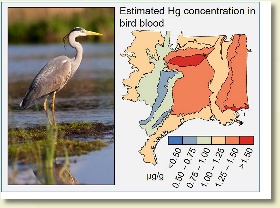
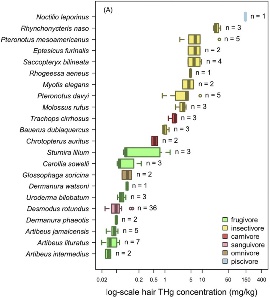


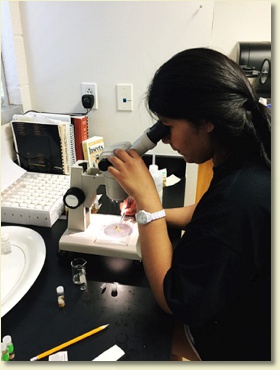

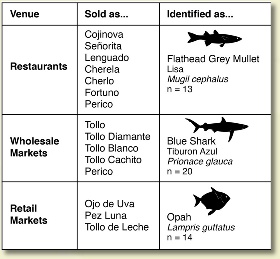
Mercury Research
Recent projects
Landscape-level patterns of mercury contamination of fish in North Texas, USA
Investigators: Ray W. Drenner, Matthew M. Chumchal, Stephen P. Wente, Mandy McGuire, and S. Matthew Drenner
Abstract: Mercury (Hg) is a toxic metal that is found in aquatic food webs and is hazardous to humans. An emerging conceptual model predicts that the areas of the landscape that have the potential to contain food webs with elevated concentrations of Hg are those that receive high amounts of Hg and sulfate deposition and have high coverage of forests and wetlands and low coverage of agriculture. The objective of the present study was to test this conceptual model using concentrations of Hg in largemouth bass (Micropterus salmoides) from 145 reservoirs in four ecoregions of North Texas. The highest level of Hg contamination in fish was in the South Central Plains, the ecoregion that receives highest levels of Hg and sulfate deposition and contains extensive forest and wetland habitat and little agriculture. The present study has important implications for other areas of the United States because the South Central Plains extends into parts of Oklahoma, Louisiana and Arkansas, covering a total area of 152,132 km2 of the southern U.S.
Click here to download the article published in Environmental Toxicology and Chemistry
Investigators: Ray W. Drenner, Matthew M. Chumchal, Stephen P. Wente, Mandy McGuire, and S. Matthew Drenner
Abstract: Mercury (Hg) is a toxic metal that is found in aquatic food webs and is hazardous to humans. An emerging conceptual model predicts that the areas of the landscape that have the potential to contain food webs with elevated concentrations of Hg are those that receive high amounts of Hg and sulfate deposition and have high coverage of forests and wetlands and low coverage of agriculture. The objective of the present study was to test this conceptual model using concentrations of Hg in largemouth bass (Micropterus salmoides) from 145 reservoirs in four ecoregions of North Texas. The highest level of Hg contamination in fish was in the South Central Plains, the ecoregion that receives highest levels of Hg and sulfate deposition and contains extensive forest and wetland habitat and little agriculture. The present study has important implications for other areas of the United States because the South Central Plains extends into parts of Oklahoma, Louisiana and Arkansas, covering a total area of 152,132 km2 of the southern U.S.
Click here to download the article published in Environmental Toxicology and Chemistry
Mercury speciation and biomagnification in the food web of Caddo Lake, Texas and
Louisiana, USA, a subtropical freshwater ecosystem
Investigators: Matthew M. Chumchal, Thomas R. Rainwater, Steven Osborn, Aaron Roberts, Michael T. Abel, George P. Cobb, Philip N. Smith, and Frank C. Bailey
Abstract: We studied the biomagnification of total mercury and methylmercury in a subtropical freshwater lake, Caddo Lake, Texas and Louisiana, USA. The present study is unique in that it not only included invertebrates (seven species) and fish (six species) but also an amphibian (one species), reptiles (three species), and mammals (three species). Nonfish vertebrates such as those included in the present study are often not included in assessments of trophic transfer of Hg. Mean trophic position (determined using stable isotopes of nitrogen) ranged from 2.0 (indicative of a primary consumer) to 3.8 (indicative of a tertiary consumer). Mean total Hg concentrations ranged from 36 to 3,292 ng/g dry weight in muscle and whole body and from 150 to 30,171 ng/g dry weight in liver. Most of the Hg in muscle and whole-body tissue was found as methylmercury, and at least 50% of the Hg found in liver was in the inorganic form (with the exception of largemouth bass, Micropterus salmoides). Mercury concentrations were positively correlated with trophic position, indicating that biomagnification occurs in the food web of Caddo Lake. The food web magnification factors (FWMFs; slope of the relationship between mean Hg concentration and trophic position) for both total Hg and methylmercury were similar to those observed in other studies. Because most of the total Hg in consumers was methylmercury, the FWMF for methylmercury was not significantly different from the FWMF for total Hg. Some vertebrates examined in the present study had low Hg concentrations in their tissues similar to those observed in invertebrates, whereas others had concentrations of Hg in their tissues that in previous studies have been associated with negative health consequences in fish.
Click here to download the article published in Environmental Toxicology and Chemistry
Investigators: Matthew M. Chumchal, Thomas R. Rainwater, Steven Osborn, Aaron Roberts, Michael T. Abel, George P. Cobb, Philip N. Smith, and Frank C. Bailey
Abstract: We studied the biomagnification of total mercury and methylmercury in a subtropical freshwater lake, Caddo Lake, Texas and Louisiana, USA. The present study is unique in that it not only included invertebrates (seven species) and fish (six species) but also an amphibian (one species), reptiles (three species), and mammals (three species). Nonfish vertebrates such as those included in the present study are often not included in assessments of trophic transfer of Hg. Mean trophic position (determined using stable isotopes of nitrogen) ranged from 2.0 (indicative of a primary consumer) to 3.8 (indicative of a tertiary consumer). Mean total Hg concentrations ranged from 36 to 3,292 ng/g dry weight in muscle and whole body and from 150 to 30,171 ng/g dry weight in liver. Most of the Hg in muscle and whole-body tissue was found as methylmercury, and at least 50% of the Hg found in liver was in the inorganic form (with the exception of largemouth bass, Micropterus salmoides). Mercury concentrations were positively correlated with trophic position, indicating that biomagnification occurs in the food web of Caddo Lake. The food web magnification factors (FWMFs; slope of the relationship between mean Hg concentration and trophic position) for both total Hg and methylmercury were similar to those observed in other studies. Because most of the total Hg in consumers was methylmercury, the FWMF for methylmercury was not significantly different from the FWMF for total Hg. Some vertebrates examined in the present study had low Hg concentrations in their tissues similar to those observed in invertebrates, whereas others had concentrations of Hg in their tissues that in previous studies have been associated with negative health consequences in fish.
Click here to download the article published in Environmental Toxicology and Chemistry
Factors influencing mercury accumulation in three species of forage fish from Caddo
Lake, Texas, USA
Investigators: Matthew M Chumchal, Ray W Drenner, David R Cross, K David Hambright
Abstract: Most studies that have examined mercury (Hg) contamination of fish have focused on game species feeding near the top of the food web, while studies that examine forage fish that feed near the base of the food web are rare. We conducted a survey of Hg contamination in three species of forage fish, brook silverside (Labidesthes sicculus), threadfin shad (Dorosoma petenense) and gizzard shad (Dorosoma cepedianum), from Caddo Lake, Texas, USA and found species-specific differences in Hg concentrations. We examined total length, age, trophic position (determined using delta 15N), and growth rate of forage fish as factors that could have influenced within- and between-species differences in Hg concentration. Total length and age were the best predictors of within-species differences in Hg concentration. Between-species differences in Hg concentrations were most strongly influenced by trophic position.
Click here to download the article published in Journnal of Environmental Sciences
Investigators: Matthew M Chumchal, Ray W Drenner, David R Cross, K David Hambright
Abstract: Most studies that have examined mercury (Hg) contamination of fish have focused on game species feeding near the top of the food web, while studies that examine forage fish that feed near the base of the food web are rare. We conducted a survey of Hg contamination in three species of forage fish, brook silverside (Labidesthes sicculus), threadfin shad (Dorosoma petenense) and gizzard shad (Dorosoma cepedianum), from Caddo Lake, Texas, USA and found species-specific differences in Hg concentrations. We examined total length, age, trophic position (determined using delta 15N), and growth rate of forage fish as factors that could have influenced within- and between-species differences in Hg concentration. Total length and age were the best predictors of within-species differences in Hg concentration. Between-species differences in Hg concentrations were most strongly influenced by trophic position.
Click here to download the article published in Journnal of Environmental Sciences
Use of Preserved Museum Fish to Evaluate Historical and Current Mercury
Contamination in Fish from Two Oklahoma Rivers
Investigators: J. Jaron Hill, Ray W. Drenner, Matthew M. Chumchal, And John E. Pinder III
Abstract: We examined the effects of a commonly-used preservation technique on mercury concentration in fish tissue. After fixing fish tissue in formalin followed by preservation in isoproponal, we found that mercury concentration in fish increased by 18%, reaching an asymptote after 40 days. We used formalin-isopropanol preserved longear sunfish (Lepomis megalotis) from the Sam Noble Oklahoma Museum of Natural History to examine historical changes and predict current mercury concentrations in fish from two rivers in southeastern Oklahoma. Glover River was free-flowing while Mountain Fork River was impounded in 1970 and a coldwater trout fishery established upstream from the collection site in 1989. Mercury concentrations in longear sunfish from Glover River showed no historical changes from 1963 to 2001. Mercury concentrations in longear sunfish from Mountain Fork River showed no change from 1925 to 1993 but declined from 1993 to 2003. We also compared mercury concentrations of the most recently collected longear sunfish in the museum to mercury concentrations of unpreserved fish collected from the rivers in 2006. Concentrations of mercury in museum fish were not different from mercury concentrations in unpreserved fish we collected from the rivers. Our study indicates that preserved museum fish can be used to evaluate historical changes and predict current levels of mercury contamination in fish.
Click here to download the article published in Environmental Monitoring and Assessment
Investigators: J. Jaron Hill, Ray W. Drenner, Matthew M. Chumchal, And John E. Pinder III
Abstract: We examined the effects of a commonly-used preservation technique on mercury concentration in fish tissue. After fixing fish tissue in formalin followed by preservation in isoproponal, we found that mercury concentration in fish increased by 18%, reaching an asymptote after 40 days. We used formalin-isopropanol preserved longear sunfish (Lepomis megalotis) from the Sam Noble Oklahoma Museum of Natural History to examine historical changes and predict current mercury concentrations in fish from two rivers in southeastern Oklahoma. Glover River was free-flowing while Mountain Fork River was impounded in 1970 and a coldwater trout fishery established upstream from the collection site in 1989. Mercury concentrations in longear sunfish from Glover River showed no historical changes from 1963 to 2001. Mercury concentrations in longear sunfish from Mountain Fork River showed no change from 1925 to 1993 but declined from 1993 to 2003. We also compared mercury concentrations of the most recently collected longear sunfish in the museum to mercury concentrations of unpreserved fish collected from the rivers in 2006. Concentrations of mercury in museum fish were not different from mercury concentrations in unpreserved fish we collected from the rivers. Our study indicates that preserved museum fish can be used to evaluate historical changes and predict current levels of mercury contamination in fish.
Click here to download the article published in Environmental Monitoring and Assessment
Mercury contamination of the fish community of a semi-arid and arid river systems:
Spatial variation and the influence of environmental gradients
Investgators: Alexandra Smith, Alisa A. Abuzeineh, Matthew M. Chumchal, Timothy H. Bonner, and Weston H. Nowlin
Abstract: Mercury (Hg) contamination of aquatic ecosystems is a global environmental problem. Data are abundant on Hg contamination and factors that affect its bioaccumulation in lake communities, but comparatively little information on riverine ecosystems exists. The present study examines fish Hg concentrations of the Lower Rio Grande/Rio Bravo del Norte drainage, Texas, USA and several of its major tributaries in order to assess whether spatial variation occurs in fish Hg concentrations in the drainage and if patterns of Hg contamination of fish are related to gradients in environmental factors thought to affect Hg concentrations in fish communities. Fish, invertebrates, sediments, and water quality parameters were sampled at 12 sites along the lower Rio Grande/Rio Bravo del Norte drainage multiple times over a one-year period. Spatial variation was significant in fish Hg concentrations when fish were grouped by literature-defined trophic guilds or as stable isotope-defined trophic levels, with highest concentrations found in the Big Bend region of the drainage. Mercury in fish in most trophic guilds and trophic levels were positively related to environmental factors thought to affect Hg in fish, including water column dissolved organic carbon (DOC) and sediment Hg concentrations. It is likely that fish Hg concentrations in the Big Bend region are relatively high because this section of the river has abundant geologic Hg sources and environmental conditions which may make it sensitive to Hg inputs (i.e., high DOC, variable water levels). Results from the present study indicate thatHg contamination of the Rio Grande/Rio Bravo del Norte has substantial implications for management and protection of native small-bodied obligate riverine fish, many of which are imperiled.
Click here to download the article published in Environmental Toxicology and Chemistry
Investgators: Alexandra Smith, Alisa A. Abuzeineh, Matthew M. Chumchal, Timothy H. Bonner, and Weston H. Nowlin
Abstract: Mercury (Hg) contamination of aquatic ecosystems is a global environmental problem. Data are abundant on Hg contamination and factors that affect its bioaccumulation in lake communities, but comparatively little information on riverine ecosystems exists. The present study examines fish Hg concentrations of the Lower Rio Grande/Rio Bravo del Norte drainage, Texas, USA and several of its major tributaries in order to assess whether spatial variation occurs in fish Hg concentrations in the drainage and if patterns of Hg contamination of fish are related to gradients in environmental factors thought to affect Hg concentrations in fish communities. Fish, invertebrates, sediments, and water quality parameters were sampled at 12 sites along the lower Rio Grande/Rio Bravo del Norte drainage multiple times over a one-year period. Spatial variation was significant in fish Hg concentrations when fish were grouped by literature-defined trophic guilds or as stable isotope-defined trophic levels, with highest concentrations found in the Big Bend region of the drainage. Mercury in fish in most trophic guilds and trophic levels were positively related to environmental factors thought to affect Hg in fish, including water column dissolved organic carbon (DOC) and sediment Hg concentrations. It is likely that fish Hg concentrations in the Big Bend region are relatively high because this section of the river has abundant geologic Hg sources and environmental conditions which may make it sensitive to Hg inputs (i.e., high DOC, variable water levels). Results from the present study indicate thatHg contamination of the Rio Grande/Rio Bravo del Norte has substantial implications for management and protection of native small-bodied obligate riverine fish, many of which are imperiled.
Click here to download the article published in Environmental Toxicology and Chemistry
Ecological Factors Regulating Mercury Contamination of Fish from Caddo Lake, Texas
USA
Investigators: Matthew M. Chumchal and K. David Hambright
Abstract: Most studies examining the influence of ecological characteristics of fish on Hg concentration in fish tissues have focused on a few variables and been conducted in northern ecosystems. We examined how total length (TL), age, food-web position (estimated using delta13C and delta15N), and habitat were related to total Hg concentrations in 10 species of fish from Caddo Lake, a subtropical reservoir located on the border of Texas and Louisiana, USA. We observed biomagnification in the Caddo Lake fish assemblage, and the enrichment factors (the slope of the relationship between delta15N and total Hg concentration) in the two habitats were 0.19 and 0.24, similar to those found in other studies. Although trophic position was the best predictor of total Hg concentration between species, age and TL were the best predictors of total Hg concentration within species. Unlike studies conducted in deep lakes, delta13C values of fish tissue, a measure of the extent to which fish feed in food webs based on pelagic or littoral primary production, was not a good predictor of total Hg concentration in Caddo Lake fish. Total Hg concentrations in fish were elevated in forested-wetland habitats relative to open-water habitats. Data collected in the present study indicate that more Hg likely was available for incorporation into the base of the food web in the forested-wetland habitat than in the open-water habitat. Our results help to clarify the relationship between ecological characteristics of fish and Hg concentration in fish tissue and can be used by
researchers as well as public and environmental health officials when designing Hg monitoring studies.
Click here to download the article published in Environmental Toxicology and Chemistry
Investigators: Matthew M. Chumchal and K. David Hambright
Abstract: Most studies examining the influence of ecological characteristics of fish on Hg concentration in fish tissues have focused on a few variables and been conducted in northern ecosystems. We examined how total length (TL), age, food-web position (estimated using delta13C and delta15N), and habitat were related to total Hg concentrations in 10 species of fish from Caddo Lake, a subtropical reservoir located on the border of Texas and Louisiana, USA. We observed biomagnification in the Caddo Lake fish assemblage, and the enrichment factors (the slope of the relationship between delta15N and total Hg concentration) in the two habitats were 0.19 and 0.24, similar to those found in other studies. Although trophic position was the best predictor of total Hg concentration between species, age and TL were the best predictors of total Hg concentration within species. Unlike studies conducted in deep lakes, delta13C values of fish tissue, a measure of the extent to which fish feed in food webs based on pelagic or littoral primary production, was not a good predictor of total Hg concentration in Caddo Lake fish. Total Hg concentrations in fish were elevated in forested-wetland habitats relative to open-water habitats. Data collected in the present study indicate that more Hg likely was available for incorporation into the base of the food web in the forested-wetland habitat than in the open-water habitat. Our results help to clarify the relationship between ecological characteristics of fish and Hg concentration in fish tissue and can be used by
researchers as well as public and environmental health officials when designing Hg monitoring studies.
Click here to download the article published in Environmental Toxicology and Chemistry
Mercury Contamination of Macroinvertebrates in Fishless Grassland Ponds
Investigators: Bradley D. Blackwell and Ray W. Drenner
Abstract: We surveyed mercury concentrations of aquatic macroinvertebrates collected from fishless ponds on the Lyndon B. Johnson National Grassland, Texas. Macroinvertebrates representing eight taxonomic groups were collected from 13 ponds in June 2006. Significant differences in mercury concentrations were detected among the taxonomic groups, with the omnivore Hydrophilidae and the predator Notonectidae containing the lowest and highest concentrations of mercury, respectively. We also detected significant differences in mercury concentrations of macroinvertebrates in the different ponds. The mercury concentrations of some macroinvertebrates were above recommended thresholds for consumption by bird species. Our study suggests that fishless ponds can produce large populations of mercury-contaminated macroinvertebrates that could be harmful to aquatic and terrestrial consumers.
Click here to download the article published in The Southwestern Naturalist
Investigators: Bradley D. Blackwell and Ray W. Drenner
Abstract: We surveyed mercury concentrations of aquatic macroinvertebrates collected from fishless ponds on the Lyndon B. Johnson National Grassland, Texas. Macroinvertebrates representing eight taxonomic groups were collected from 13 ponds in June 2006. Significant differences in mercury concentrations were detected among the taxonomic groups, with the omnivore Hydrophilidae and the predator Notonectidae containing the lowest and highest concentrations of mercury, respectively. We also detected significant differences in mercury concentrations of macroinvertebrates in the different ponds. The mercury concentrations of some macroinvertebrates were above recommended thresholds for consumption by bird species. Our study suggests that fishless ponds can produce large populations of mercury-contaminated macroinvertebrates that could be harmful to aquatic and terrestrial consumers.
Click here to download the article published in The Southwestern Naturalist
Effect of Trawling and Habitat on Mercury Concentration in Juvenile Red Snapper from
the Northern Gulf of Mexico
Investigators: R.J. David Wells, Matthew M. Chumchal, and James H. Cowan, Jr.
Abstract: We evaluated mercury (Hg) contamination in juvenile red snapper Lutjanus campechanus (250 mm total length) as an indicator of Hg pollution on the northern Gulf of Mexico (GOM) continental shelf. Specifically, we examined the effects of fish size, commercial shrimp trawling, and habitat type on total Hg concentrations and stable nitrogen isotope ratios (d15N; a proxy for trophic position) in red snapper. Red snapper Hg concentrations and d15N values were positively and significantly correlated with fish size. In addition, red snapper collected over trawled habitats had significantly higher Hg concentrations and delta15N values than did red snapper collected from similar, nontrawled habitats. Red snapper also exhibited habitat specific differences in Hg concentrations and d15N values, but differences were size dependent and generally small. Our study suggests that the Hg concentrations of juvenile red snapper in the northern GOM are elevated in areas where commercial shrimp trawling occurs, possibly due to increases in both red snapper trophic position and bioavailable Hg in trawled areas. Additional studies are needed to determine whether Hg concentrations are elevated in fish from trawled areas in other marine ecosystems.
Click here to download the article published in Transactions of the American Fisheries Society
Investigators: R.J. David Wells, Matthew M. Chumchal, and James H. Cowan, Jr.
Abstract: We evaluated mercury (Hg) contamination in juvenile red snapper Lutjanus campechanus (250 mm total length) as an indicator of Hg pollution on the northern Gulf of Mexico (GOM) continental shelf. Specifically, we examined the effects of fish size, commercial shrimp trawling, and habitat type on total Hg concentrations and stable nitrogen isotope ratios (d15N; a proxy for trophic position) in red snapper. Red snapper Hg concentrations and d15N values were positively and significantly correlated with fish size. In addition, red snapper collected over trawled habitats had significantly higher Hg concentrations and delta15N values than did red snapper collected from similar, nontrawled habitats. Red snapper also exhibited habitat specific differences in Hg concentrations and d15N values, but differences were size dependent and generally small. Our study suggests that the Hg concentrations of juvenile red snapper in the northern GOM are elevated in areas where commercial shrimp trawling occurs, possibly due to increases in both red snapper trophic position and bioavailable Hg in trawled areas. Additional studies are needed to determine whether Hg concentrations are elevated in fish from trawled areas in other marine ecosystems.
Click here to download the article published in Transactions of the American Fisheries Society
Habitat-Specific Differences in Mercury Concentration in a Top Predator from a Shallow
Lake
Investigators: Matthew M. Chumchal, Ray W. Drenner, Brian Fry, K. David Hambright, and Leo W. Newland.
Abstract: We conducted a survey of mercury contamination in largemouth bass Micropterus salmoides from Caddo Lake, Texas, and found that fish collected from forested wetland habitat had higher concentrations of mercury than those collected from open-water habitat. Habitat-specific differences in largemouth bass size, age, absolute growth rate, trophic position (based on d15N), and horizontal food web position (based on d13C), characteristics known to influence mercury accumulation, did not explain the observed differences in mercury contamination. Rather, habitat-related differences in mercury concentration in a primary consumer, Mississippi grass shrimp Palaemonetes kadiakensis, indicated that food webs in forested wetland habitat were more contaminated with mercury than those in open-water habitat. Spatial variation in mercury contamination within lakes and elevated mercury concentrations in forested wetlands should be of special concern not only to researchers but also to public and environmental health officials dealing with mercury contamination in aquatic environments and human health risks associated with consumption of fish contaminated with mercury.
Click here to download the article published in Transactions of the American Fisheries Society
Investigators: Matthew M. Chumchal, Ray W. Drenner, Brian Fry, K. David Hambright, and Leo W. Newland.
Abstract: We conducted a survey of mercury contamination in largemouth bass Micropterus salmoides from Caddo Lake, Texas, and found that fish collected from forested wetland habitat had higher concentrations of mercury than those collected from open-water habitat. Habitat-specific differences in largemouth bass size, age, absolute growth rate, trophic position (based on d15N), and horizontal food web position (based on d13C), characteristics known to influence mercury accumulation, did not explain the observed differences in mercury contamination. Rather, habitat-related differences in mercury concentration in a primary consumer, Mississippi grass shrimp Palaemonetes kadiakensis, indicated that food webs in forested wetland habitat were more contaminated with mercury than those in open-water habitat. Spatial variation in mercury contamination within lakes and elevated mercury concentrations in forested wetlands should be of special concern not only to researchers but also to public and environmental health officials dealing with mercury contamination in aquatic environments and human health risks associated with consumption of fish contaminated with mercury.
Click here to download the article published in Transactions of the American Fisheries Society
Mercury concentrations in fish from Lake Meredith, Texas: Implications for the issuance
of fish consumption advisories
Investigators: William C. McClain, Matthew M. Chumchal, Ray W. Drenner, and Leo W. Newland
Abstract: We examined how length of fish is related to mercury concentrations in muscle tissue of seven species of fish from Lake Meredith, Texas and determined how sex and growth rate are related to mercury concentration in walleye (Sander vitreus). Flathead catfish (Pylodictis olivaris), walleye and white bass (Morone chrysops) had the highest concentrations of mercury and channel catfish (Ictalurus punctatus), common carp (Cyprinus carpio), river carpsucker (Carpiodes carpio) and gizzard shad (Dorosoma cepedianum) had the lowest concentrations of mercury. Mercury concentrations were positively correlated with total length (TL) of fish for all species except gizzard shad, which exhibited a negative correlation between mercury concentration and TL. Male walleye grew more slowly than females, and males had higher concentrations of mercury than females.We also assessed the differences in fish consumption advisories that would be issued using Texas Department of State Health Services (DSHS) guidelines versus United States Environmental Protection Agency (USEPA) recommendations. Using DSHS guidelines, no fish species in Lake Meredith would be issued a fish consumption advisory. Nevertheless, DSHS has issued an advisory for walleye in Lake Meredith, possibly due to an inadequate sample size of fish. Using USEPA guidelines, a fish consumption advisory would be issued for the largest size class of flathead catfish but no advisory exists for flathead catfish in Lake Meredith. We suggest that when fish in a lake may be contaminated with mercury, all game fish in the lake should be assessed, and mercury advisories should take fish size into account.
Click here to download the article published in Environmental Monitoring and Assessment
Investigators: William C. McClain, Matthew M. Chumchal, Ray W. Drenner, and Leo W. Newland
Abstract: We examined how length of fish is related to mercury concentrations in muscle tissue of seven species of fish from Lake Meredith, Texas and determined how sex and growth rate are related to mercury concentration in walleye (Sander vitreus). Flathead catfish (Pylodictis olivaris), walleye and white bass (Morone chrysops) had the highest concentrations of mercury and channel catfish (Ictalurus punctatus), common carp (Cyprinus carpio), river carpsucker (Carpiodes carpio) and gizzard shad (Dorosoma cepedianum) had the lowest concentrations of mercury. Mercury concentrations were positively correlated with total length (TL) of fish for all species except gizzard shad, which exhibited a negative correlation between mercury concentration and TL. Male walleye grew more slowly than females, and males had higher concentrations of mercury than females.We also assessed the differences in fish consumption advisories that would be issued using Texas Department of State Health Services (DSHS) guidelines versus United States Environmental Protection Agency (USEPA) recommendations. Using DSHS guidelines, no fish species in Lake Meredith would be issued a fish consumption advisory. Nevertheless, DSHS has issued an advisory for walleye in Lake Meredith, possibly due to an inadequate sample size of fish. Using USEPA guidelines, a fish consumption advisory would be issued for the largest size class of flathead catfish but no advisory exists for flathead catfish in Lake Meredith. We suggest that when fish in a lake may be contaminated with mercury, all game fish in the lake should be assessed, and mercury advisories should take fish size into account.
Click here to download the article published in Environmental Monitoring and Assessment
Copyright 2020 Matt Chumchal
Texas Christian University
2800 S. University Dr.
Fort Worth, Texas 76129
Texas Christian University
2800 S. University Dr.
Fort Worth, Texas 76129
Laser Ablation ICP-MS Co-Localization of Mercury and Immune Response in Fish
Investigators: Benjamin D. Barst, Amanda K. Gevertz, Matthew M. Chumchal, James D. Smith, Thomas R. Rainwater, Paul E. Drevnick, Karista E. Hudelson, Aaron Hart, Guido F. Verbeck, and Aaron P. Roberts
Abstract: Mercury (Hg) contamination is a global issue with implications for both ecosystem and human health. In this study, we use a new approach to link Hg exposure to health effects in spotted gar (Lepisosteus oculatus) from Caddo Lake (TX/LA). Previous field studies have reported elevated incidences of macrophage centers in liver, kidney, and spleen of fish with high concentrations of Hg. Macrophage centers are aggregates of specialized white blood cells that form as an immune response to tissue damage, and are considered a general biomarker of contaminant toxicity. We found elevated incidences of macrophage centers in liver of spotted gar and used a new technology for ecotoxicology studies, laser ablation-inductively coupled plasma-mass spectrometry (LA-ICPMS), to colocalize aggregates and Hg deposits within the tissue architecture. We conclude that Hg compromises the health of spotted gar in our study and, perhaps, other fish exposed to elevated concentrations of Hg.
Click here to download the article published in Environmental Science and Technology
Investigators: Benjamin D. Barst, Amanda K. Gevertz, Matthew M. Chumchal, James D. Smith, Thomas R. Rainwater, Paul E. Drevnick, Karista E. Hudelson, Aaron Hart, Guido F. Verbeck, and Aaron P. Roberts
Abstract: Mercury (Hg) contamination is a global issue with implications for both ecosystem and human health. In this study, we use a new approach to link Hg exposure to health effects in spotted gar (Lepisosteus oculatus) from Caddo Lake (TX/LA). Previous field studies have reported elevated incidences of macrophage centers in liver, kidney, and spleen of fish with high concentrations of Hg. Macrophage centers are aggregates of specialized white blood cells that form as an immune response to tissue damage, and are considered a general biomarker of contaminant toxicity. We found elevated incidences of macrophage centers in liver of spotted gar and used a new technology for ecotoxicology studies, laser ablation-inductively coupled plasma-mass spectrometry (LA-ICPMS), to colocalize aggregates and Hg deposits within the tissue architecture. We conclude that Hg compromises the health of spotted gar in our study and, perhaps, other fish exposed to elevated concentrations of Hg.
Click here to download the article published in Environmental Science and Technology
Spatial variability in the speciation and bioaccumulation of mercury in an arid subtropical
reservoir ecosystem
Investigators: Jesse Becker, Alan Groeger, Weston Nowlin, Matthew Chumchal, and Dittmar Hahn
Abstract:Patterns of spatial variation of mercury and methylmercury (MeHg) were examined in sediments and muscle tissue of largemouth bass (Micropterus salmoides) from Amistad International Reservoir, a large and hydrologically complex subtropical water body in the Rio Grande drainage. The distributions of both Hg and MeHg were compared with environmental and biological factors known to influence production of MeHg. The highest concentrations of total Hg (THg) in sediment were found in the Rio Grande arm of the reservoir, whereas MeHg was highest at sites in the Devils River arm and inundated Pecos River (often more than 3.0 ng/g).Conditions in the sediments of the Devils River arm and Pecos River channel were likely more favorable to the production of MeHg, with higher sediment porewater dissolved organic carbon, and porewater sulfate levels in the optimal range for methylation. Although the detection of different groups of sulfate-reducing bacteria by polymerase chain reaction (PCR) was generally correlated with MeHg concentrations, bacterial counts via fluorescent in situ hybridization (FISH) did not correlate with MeHg. A sample of 156 largemouth bass (<30 cm) showed a spatial pattern similar to that of MeHg in sediments, where fish from the Devils River arm of the reservoir had higher muscle Hg concentrations than those collected in the Rio Grande arm. In 88 bass of legal sport fishing size (>35 cm), 77% exceeded the 0.3 mg/kg U.S. Environmental Protection Agency screening value. This study shows that significant variation in sediment MeHg and biotic Hg concentration can exist within lakes and reservoirs and that it can correspond to variation in environmental conditions and Hg methylation.
Click here to download the article published in Environmental Toxicology and Chemistry
Investigators: Jesse Becker, Alan Groeger, Weston Nowlin, Matthew Chumchal, and Dittmar Hahn
Abstract:Patterns of spatial variation of mercury and methylmercury (MeHg) were examined in sediments and muscle tissue of largemouth bass (Micropterus salmoides) from Amistad International Reservoir, a large and hydrologically complex subtropical water body in the Rio Grande drainage. The distributions of both Hg and MeHg were compared with environmental and biological factors known to influence production of MeHg. The highest concentrations of total Hg (THg) in sediment were found in the Rio Grande arm of the reservoir, whereas MeHg was highest at sites in the Devils River arm and inundated Pecos River (often more than 3.0 ng/g).Conditions in the sediments of the Devils River arm and Pecos River channel were likely more favorable to the production of MeHg, with higher sediment porewater dissolved organic carbon, and porewater sulfate levels in the optimal range for methylation. Although the detection of different groups of sulfate-reducing bacteria by polymerase chain reaction (PCR) was generally correlated with MeHg concentrations, bacterial counts via fluorescent in situ hybridization (FISH) did not correlate with MeHg. A sample of 156 largemouth bass (<30 cm) showed a spatial pattern similar to that of MeHg in sediments, where fish from the Devils River arm of the reservoir had higher muscle Hg concentrations than those collected in the Rio Grande arm. In 88 bass of legal sport fishing size (>35 cm), 77% exceeded the 0.3 mg/kg U.S. Environmental Protection Agency screening value. This study shows that significant variation in sediment MeHg and biotic Hg concentration can exist within lakes and reservoirs and that it can correspond to variation in environmental conditions and Hg methylation.
Click here to download the article published in Environmental Toxicology and Chemistry
Effects of fish on mercury contamination of macroinvertebrate communities of grassland
ponds
Investigators: Byron L. Hennderson, Matthew M. Chumchal, Ray W. Drenner, Yanci Deng, Pete Diaz, Weston H. Nowlin
Abstract: Mercury is an environmental contaminant that negatively affects the health of vertebrate consumers such as fish, birds, and mammals. Although aquatic macroinvertebrates are a key link in the trophic transfer of Hg to vertebrate consumers, Hg contamination in macroinvertebrate communities has not been well studied. The purpose of the present study was to examine how Hg in macroinvertebrate communities is affected by the presence of fish. We sampled macroinvertebrates from five ponds with fish and five ponds without fish, at the Lyndon B. Johnson National Grassland in north Texas, USA. Ponds without fish contained a higher biomass of macroinvertebrates and taxa with higher concentrations of Hg, which led to a higher Hg pool in the macroinvertebrate community. A total of 73% of the macroinvertebrate biomass from ponds without fish was composed of taxa with the potential to emerge and transport Hg out of ponds into terrestrial food webs. The results of the present study suggest that small ponds, the numerically dominant aquatic ecosystems in the United States, may be more at risk for containing organisms with elevated Hg concentrations than has been appreciated.
Click here to download the article published in Environmental Toxicology and Chemistry
Investigators: Byron L. Hennderson, Matthew M. Chumchal, Ray W. Drenner, Yanci Deng, Pete Diaz, Weston H. Nowlin
Abstract: Mercury is an environmental contaminant that negatively affects the health of vertebrate consumers such as fish, birds, and mammals. Although aquatic macroinvertebrates are a key link in the trophic transfer of Hg to vertebrate consumers, Hg contamination in macroinvertebrate communities has not been well studied. The purpose of the present study was to examine how Hg in macroinvertebrate communities is affected by the presence of fish. We sampled macroinvertebrates from five ponds with fish and five ponds without fish, at the Lyndon B. Johnson National Grassland in north Texas, USA. Ponds without fish contained a higher biomass of macroinvertebrates and taxa with higher concentrations of Hg, which led to a higher Hg pool in the macroinvertebrate community. A total of 73% of the macroinvertebrate biomass from ponds without fish was composed of taxa with the potential to emerge and transport Hg out of ponds into terrestrial food webs. The results of the present study suggest that small ponds, the numerically dominant aquatic ecosystems in the United States, may be more at risk for containing organisms with elevated Hg concentrations than has been appreciated.
Click here to download the article published in Environmental Toxicology and Chemistry
Mercury bioaccumulation in estuarine food webs
Investigators: Brian Fry and Matthew M. Chumchal
Abstract: We tested for unintended mercury contamination problems associated with estuarine floodplain restoration projects of the Louisiana coastal zone, USA. Barataria Bay and Breton Sound are two neighboring deltaic estuaries that were isolated by levees from the Mississippi River about 100 years ago. These estuaries recently have been reconnected to the nutrient-rich Mississippi River, starting major river diversion (input) flows in 1991 for Breton Sound and in 2004 for Barataria Bay. We collected >2100 fish over five years from 20 stations in these estuaries to test two hypotheses about Hg bioaccumulation: (H1) Background Hg bioaccumulation in fish would be highest in low-salinity upper reaches of estuaries, and (H2) recent river inputs to these upper estuarine areas would increase Hg bioaccumulation in fish food webs. For H1, we surveyed fish Hg concentrations at several stations along a salinity gradient in Barataria Bay in 2003–2004, a time when this estuary lacked strong river inputs. Results showed that average Hg concentrations in fish communities were lowest (150 ng/g dry mass) in higher salinity areas and 2.4× higher (350 ng/g) in low-salinity oligohaline and freshwater upper reaches of the estuary. For H2, we tested for enhanced Hg bioaccumulation following diversion onset in both estuaries. Fish communities from Breton Sound that had long-term (>10 years) diversion inputs had 1.7× higher average Hg contents of 610 ng/g Hg vs. 350 ng/g background values. Shorter-term diversion inputs over 2–3 years in upper Barataria Bay did not result in strong Hg enrichments or stable C isotope increases seen in Breton Sound, even though N and S stable-isotope values indicated strong river inputs in both estuaries. It may be that epiphyte communities on abundant submerged aquatic vegetation (SAV) are important hotspots for Hg cycling in these estuaries, and observed lesser development of these epiphyte communities in upper Barataria Bay during the first years of diversion inputs may account for the lessened Hg bioaccumulation in fish. A management consideration from this study is that river restoration projects may unintentionally fertilize SAV and epiphyte-based food webs, leading to higher Hg bioaccumulation in river-impacted floodplains and their food webs.
Click here to download the article published in Ecological Applications
Investigators: Brian Fry and Matthew M. Chumchal
Abstract: We tested for unintended mercury contamination problems associated with estuarine floodplain restoration projects of the Louisiana coastal zone, USA. Barataria Bay and Breton Sound are two neighboring deltaic estuaries that were isolated by levees from the Mississippi River about 100 years ago. These estuaries recently have been reconnected to the nutrient-rich Mississippi River, starting major river diversion (input) flows in 1991 for Breton Sound and in 2004 for Barataria Bay. We collected >2100 fish over five years from 20 stations in these estuaries to test two hypotheses about Hg bioaccumulation: (H1) Background Hg bioaccumulation in fish would be highest in low-salinity upper reaches of estuaries, and (H2) recent river inputs to these upper estuarine areas would increase Hg bioaccumulation in fish food webs. For H1, we surveyed fish Hg concentrations at several stations along a salinity gradient in Barataria Bay in 2003–2004, a time when this estuary lacked strong river inputs. Results showed that average Hg concentrations in fish communities were lowest (150 ng/g dry mass) in higher salinity areas and 2.4× higher (350 ng/g) in low-salinity oligohaline and freshwater upper reaches of the estuary. For H2, we tested for enhanced Hg bioaccumulation following diversion onset in both estuaries. Fish communities from Breton Sound that had long-term (>10 years) diversion inputs had 1.7× higher average Hg contents of 610 ng/g Hg vs. 350 ng/g background values. Shorter-term diversion inputs over 2–3 years in upper Barataria Bay did not result in strong Hg enrichments or stable C isotope increases seen in Breton Sound, even though N and S stable-isotope values indicated strong river inputs in both estuaries. It may be that epiphyte communities on abundant submerged aquatic vegetation (SAV) are important hotspots for Hg cycling in these estuaries, and observed lesser development of these epiphyte communities in upper Barataria Bay during the first years of diversion inputs may account for the lessened Hg bioaccumulation in fish. A management consideration from this study is that river restoration projects may unintentionally fertilize SAV and epiphyte-based food webs, leading to higher Hg bioaccumulation in river-impacted floodplains and their food webs.
Click here to download the article published in Ecological Applications
Biomagnification of Mercury in Aquatic Food Webs: A Worldwide Meta-Analysis
Investigators: Raphael A. Lavoie, Timothy D. Jardine, Matthew M. Chumchal, Karen A. Kidd and Linda M. Campbell
Abstract: The slope of the simple linear regression between log10 transformed mercury (Hg) concentration and stable nitrogen isotope values (d15N), hereafter called trophic magnification slope (TMS), from several trophic levels in a food web can represent the overall degree of Hg biomagnification. We compiled data from 69 studies that determined total Hg (THg) or methyl Hg (MeHg) TMS values in 205 aquatic food webs worldwide. Hg TMS values were compared against physicochemical and biological factors hypothesized to affect Hg biomagnification in aquatic systems. Food webs ranged across 1.7 ± 0.7 (mean ± SD) and 1.8 ± 0.8 trophic levels (calculated using d15N from baseline to top predator) for THg and MeHg, respectively. The average trophic level (based on d15N) of the upper-trophic-level organisms in the food web was 3.7 ± 0.8 and 3.8 ± 0.8 for THg and MeHg food webs, respectively. For MeHg, the mean TMS value was 0.24 ± 0.08 but varied from 0.08 to 0.53 and was, on average, 1.5 times higher than that for THg with a mean of 0.16 ± 0.11 (range: -0.19 to 0.48). Both THg and MeHg TMS values were significantly and positively correlated with latitude. TMS values in freshwater sites increased with dissolved organic carbon and decreased with total phosphorus and atmospheric Hg deposition. Results suggest that Hg biomagnification through food webs is highest in cold and low productivity systems; however, much of the among-system variability in TMS values remains unexplained. We identify critical data gaps and provide recommendations for future studies that would improve our understanding of global Hg biomagnification.
Click here to download the article published in Environmental Science and Technology
Investigators: Raphael A. Lavoie, Timothy D. Jardine, Matthew M. Chumchal, Karen A. Kidd and Linda M. Campbell
Abstract: The slope of the simple linear regression between log10 transformed mercury (Hg) concentration and stable nitrogen isotope values (d15N), hereafter called trophic magnification slope (TMS), from several trophic levels in a food web can represent the overall degree of Hg biomagnification. We compiled data from 69 studies that determined total Hg (THg) or methyl Hg (MeHg) TMS values in 205 aquatic food webs worldwide. Hg TMS values were compared against physicochemical and biological factors hypothesized to affect Hg biomagnification in aquatic systems. Food webs ranged across 1.7 ± 0.7 (mean ± SD) and 1.8 ± 0.8 trophic levels (calculated using d15N from baseline to top predator) for THg and MeHg, respectively. The average trophic level (based on d15N) of the upper-trophic-level organisms in the food web was 3.7 ± 0.8 and 3.8 ± 0.8 for THg and MeHg food webs, respectively. For MeHg, the mean TMS value was 0.24 ± 0.08 but varied from 0.08 to 0.53 and was, on average, 1.5 times higher than that for THg with a mean of 0.16 ± 0.11 (range: -0.19 to 0.48). Both THg and MeHg TMS values were significantly and positively correlated with latitude. TMS values in freshwater sites increased with dissolved organic carbon and decreased with total phosphorus and atmospheric Hg deposition. Results suggest that Hg biomagnification through food webs is highest in cold and low productivity systems; however, much of the among-system variability in TMS values remains unexplained. We identify critical data gaps and provide recommendations for future studies that would improve our understanding of global Hg biomagnification.
Click here to download the article published in Environmental Science and Technology
Bottom-Up Nutrient and Top-Down Fish Impacts on Insect-Mediated Mercury Flux From
Aquatic Ecosystems
Investigators: Taylor Jones, Matthew M. Chumchal, Ray W. Drenner, Gabrielle N. Timmins and Weston H. Nowlin
Abstract: Methyl mercury (MeHg) is one of the most hazardous contaminants in the environment, adversely affecting the health of wildlife and humans. Recent studies have demonstrated that aquatic insects biotransport MeHg and other contaminants to terrestrial consumers, but the factors that regulate the flux of MeHg out of aquatic ecosystems via emergent insects have not been studied. The authors used experimental mesocosms to test the hypothesis that insect emergence and the associated flux of MeHg from aquatic to terrestrial ecosystems is affected by both bottom-up nutrient effects and top-down fish consumer effects. In the present study, nutrient addition led to an increase in MeHg flux primarily by enhancing the biomass of emerging insects whose tissues were contaminated with MeHg, whereas fish decreased MeHg flux primarily by reducing the biomass of emerging insects. Furthermore, the authors found that these factors are interdependent such that the effects of nutrients are more pronounced when fish are absent, and the effects of fish are more pronounced when nutrient concentrations are high. The present study is the first to demonstrate that the flux of MeHg from aquatic to terrestrial ecosystems is strongly enhanced by bottom-up nutrient effects and diminished by top-down consumer effects.
Click here to download the article published in Environmental Toxicology and Chemistry
Investigators: Taylor Jones, Matthew M. Chumchal, Ray W. Drenner, Gabrielle N. Timmins and Weston H. Nowlin
Abstract: Methyl mercury (MeHg) is one of the most hazardous contaminants in the environment, adversely affecting the health of wildlife and humans. Recent studies have demonstrated that aquatic insects biotransport MeHg and other contaminants to terrestrial consumers, but the factors that regulate the flux of MeHg out of aquatic ecosystems via emergent insects have not been studied. The authors used experimental mesocosms to test the hypothesis that insect emergence and the associated flux of MeHg from aquatic to terrestrial ecosystems is affected by both bottom-up nutrient effects and top-down fish consumer effects. In the present study, nutrient addition led to an increase in MeHg flux primarily by enhancing the biomass of emerging insects whose tissues were contaminated with MeHg, whereas fish decreased MeHg flux primarily by reducing the biomass of emerging insects. Furthermore, the authors found that these factors are interdependent such that the effects of nutrients are more pronounced when fish are absent, and the effects of fish are more pronounced when nutrient concentrations are high. The present study is the first to demonstrate that the flux of MeHg from aquatic to terrestrial ecosystems is strongly enhanced by bottom-up nutrient effects and diminished by top-down consumer effects.
Click here to download the article published in Environmental Toxicology and Chemistry
Effects of Mercury Deposition and Coniferous Forests on the Mercury Contamination of Fish
in the South Central United States
Investigators: Ray W. Drenner, Matthew M. Chumchal, Christina M. Jones, Christopher M. B. Lehmann, David A. Gay, and David I. Donato
Abstract: Mercury (Hg) is a toxic metal that is found in aquatic food webs and is hazardous to human and wildlife health. We examined the relationship between Hg deposition, land coverage by coniferous and deciduous forests, and average Hg concentrations in largemouth bass (Micropterus salmoides)-equivalent fish (LMBE) in 14 ecoregions located within all or part of six states in the South Central U.S. In 11 ecoregions, the average Hg concentrations in 35.6-cm total length LMBE were above 300 ng/g, the threshold concentration of Hg recommended by the U.S. Environmental Protection Agency for the issuance of fish consumption advisories. Percent land coverage by coniferous forests within ecoregions had a significant linear relationship with average Hg concentrations in LMBE while percent land coverage by deciduous forests did not. Eighty percent of the variance in average Hg concentrations in LMBE between ecoregions could be accounted for by estimated Hg deposition after adjusting for the effects of coniferous forests. Here we show for the first time that fish from ecoregions with high atmospheric Hg pollution and coniferous forest coverage pose a significant hazard to human health. Our study suggests that models that use Hg deposition to predict Hg concentrations in fish could be improved by including the effects of coniferous forests on Hg deposition.
Click here to download the article published in Environmental Science and Technology
Investigators: Ray W. Drenner, Matthew M. Chumchal, Christina M. Jones, Christopher M. B. Lehmann, David A. Gay, and David I. Donato
Abstract: Mercury (Hg) is a toxic metal that is found in aquatic food webs and is hazardous to human and wildlife health. We examined the relationship between Hg deposition, land coverage by coniferous and deciduous forests, and average Hg concentrations in largemouth bass (Micropterus salmoides)-equivalent fish (LMBE) in 14 ecoregions located within all or part of six states in the South Central U.S. In 11 ecoregions, the average Hg concentrations in 35.6-cm total length LMBE were above 300 ng/g, the threshold concentration of Hg recommended by the U.S. Environmental Protection Agency for the issuance of fish consumption advisories. Percent land coverage by coniferous forests within ecoregions had a significant linear relationship with average Hg concentrations in LMBE while percent land coverage by deciduous forests did not. Eighty percent of the variance in average Hg concentrations in LMBE between ecoregions could be accounted for by estimated Hg deposition after adjusting for the effects of coniferous forests. Here we show for the first time that fish from ecoregions with high atmospheric Hg pollution and coniferous forest coverage pose a significant hazard to human health. Our study suggests that models that use Hg deposition to predict Hg concentrations in fish could be improved by including the effects of coniferous forests on Hg deposition.
Click here to download the article published in Environmental Science and Technology
Regional Variation in Mercury and Stable Isotopes of Red Snapper (Lutjanus campechanus) in
the Northern Gulf of Mexico, USA
Investigators: Michelle Zapp Sluis, Kevin M. Boswell, Matthew M. Chumchal, R.J. David Wells, Brianne Soulen and James H. Cowan Jr.
Abstract: The presence of total mercury (Hg) in fish tissue and the potential associated health risks has become a global concern in marine ecosystems. Few studies have examined basin-scale variation in Hg accumulation in marine ecosystems, and determining if Hg concentrations in fish tissue vary across marine ecosystems is a key monitoring question. The present study evaluated Hg concentrations in red snapper (Lutjanus campechanus) tissue across three regions of the northern Gulf of Mexico (Alabama, Louisiana, and Texas, USA) and between two habitat types (oil and gas platforms and nonplatforms) within each region. Nitrogen (d15N), carbon (d13C), and sulfur (d34S) stable isotopes were used to investigate ecological differences that may affect Hg concentrations among regions and between habitats. Mercury concentrations in red snapper tissue were positively correlated with fish total length. Regional differences in Hg concentrations were significant, with fish collected from Alabama having the highest concentrations and fish collected from Louisiana having the lowest. No significant difference existed in Hg concentrations between habitats, suggesting that association with platforms may not be a significant factor contributing to red snapper Hg concentrations. While d15N did not differ significantly among the three regions, Texas red snapper were more enriched in d34S and depleted in d13C compared with Alabama and Louisiana red
snapper. Although the majority of red snapper collected in the present study had Hg concentrations below safe consumption guidelines, regional differences suggest that spatially explicit monitoring programs may be important for basin-wide assessments.
Click here to download the article published in Environmental Toxicology and Chemistry
Investigators: Michelle Zapp Sluis, Kevin M. Boswell, Matthew M. Chumchal, R.J. David Wells, Brianne Soulen and James H. Cowan Jr.
Abstract: The presence of total mercury (Hg) in fish tissue and the potential associated health risks has become a global concern in marine ecosystems. Few studies have examined basin-scale variation in Hg accumulation in marine ecosystems, and determining if Hg concentrations in fish tissue vary across marine ecosystems is a key monitoring question. The present study evaluated Hg concentrations in red snapper (Lutjanus campechanus) tissue across three regions of the northern Gulf of Mexico (Alabama, Louisiana, and Texas, USA) and between two habitat types (oil and gas platforms and nonplatforms) within each region. Nitrogen (d15N), carbon (d13C), and sulfur (d34S) stable isotopes were used to investigate ecological differences that may affect Hg concentrations among regions and between habitats. Mercury concentrations in red snapper tissue were positively correlated with fish total length. Regional differences in Hg concentrations were significant, with fish collected from Alabama having the highest concentrations and fish collected from Louisiana having the lowest. No significant difference existed in Hg concentrations between habitats, suggesting that association with platforms may not be a significant factor contributing to red snapper Hg concentrations. While d15N did not differ significantly among the three regions, Texas red snapper were more enriched in d34S and depleted in d13C compared with Alabama and Louisiana red
snapper. Although the majority of red snapper collected in the present study had Hg concentrations below safe consumption guidelines, regional differences suggest that spatially explicit monitoring programs may be important for basin-wide assessments.
Click here to download the article published in Environmental Toxicology and Chemistry
Effects of Fish on Emergent Insect-Mediated Flux of Methyl Mercury across a Gradient of
Contamination
Investigators: Brent Tweedy, Ray Drenner, Matthew M. Chumchal, and James Kennedy
Abstract: We examined the effects of fish predation on emergent insect-mediated methyl mercury (MeHg) flux across a gradient of MeHg contamination in experimental ponds. Emergent insects were collected from ponds with (n = 5) and without fish (n = 5) over a six week period using floating emergence traps. We found that the potential for MeHg flux increased with Hg contamination levels of the ponds but that the realized MeHg flux of individual insect taxa was determined by fish presence. Fish acted as size-selective predators and reduced MeHg flux by suppressing emergence of large insect taxa (dragonflies and damselflies) but not small insect taxa (chironomids and microcaddisflies). MeHg flux by small insect taxa was correlated with concentrations of MeHg in terrestrial spiders along the shorelines of the study ponds, demonstrating for the first time the cross-system transport of MeHg by emergent insects to a terrestrial spider.
Click here to download the article published in Environmental Science and Technology
Investigators: Brent Tweedy, Ray Drenner, Matthew M. Chumchal, and James Kennedy
Abstract: We examined the effects of fish predation on emergent insect-mediated methyl mercury (MeHg) flux across a gradient of MeHg contamination in experimental ponds. Emergent insects were collected from ponds with (n = 5) and without fish (n = 5) over a six week period using floating emergence traps. We found that the potential for MeHg flux increased with Hg contamination levels of the ponds but that the realized MeHg flux of individual insect taxa was determined by fish presence. Fish acted as size-selective predators and reduced MeHg flux by suppressing emergence of large insect taxa (dragonflies and damselflies) but not small insect taxa (chironomids and microcaddisflies). MeHg flux by small insect taxa was correlated with concentrations of MeHg in terrestrial spiders along the shorelines of the study ponds, demonstrating for the first time the cross-system transport of MeHg by emergent insects to a terrestrial spider.
Click here to download the article published in Environmental Science and Technology
Determination of mercury speciation in fish tissue with a Direct Mercury Analyzer
Investigators: Benjamin Barst, Chad Hammerschmidt, Matthew Chumchal, Derek Muir, James Smith, Aaron Roberts, Thomas Rainwater and Paul Drevnick
Abstract: Knowledge of Hg speciation in tissue is valuable for assessing potential toxicological effects in fish. Direct Hg analyzers, which use thermal decomposition and atomic absorption spectrometry, have recently gained popularity for determining organic Hg after procedural solvent extraction from some environmental media, although quantitative recovery from lipid-rich materials, such as fish liver, has been problematic. The authors developed a new method by which organic Hg in fish liver and muscle is estimated by the difference
between direct measurements of inorganic Hg in an acid extract and total Hg in whole tissue. The method was validated by analysis of a certified reference material (DOLT-4 dogfish liver) and naturally contaminated fish tissues with comparison to an established Hg speciation method (gas chromatography cold vapor atomic fluorescence spectrometry). Recovery of organic Hg from DOLT-4, estimated by difference, averaged 99 5% of the mean certified value for methylmercury. In most liver samples and all muscle samples, estimates of organic Hg from the proposed method were indiscernible from direct speciation measurements of methylmercury (99% 6%). Estimation of organic Hg by the difference between total Hg and inorganic Hg was less accurate in liver samples with a high percentage of inorganic Hg (90%). This was because of the increased uncertainty that results from estimating a third value (i.e., organic Hg) by using the difference between two large concentrations (inorganic and total Hg). The proposed method is a useful tool for examining the speciation of Hg in fish muscle and liver, and by extension, potentially other tissues and environmental media.
Click here to download the article published in Environmental Toxicology and Chemistry
Investigators: Benjamin Barst, Chad Hammerschmidt, Matthew Chumchal, Derek Muir, James Smith, Aaron Roberts, Thomas Rainwater and Paul Drevnick
Abstract: Knowledge of Hg speciation in tissue is valuable for assessing potential toxicological effects in fish. Direct Hg analyzers, which use thermal decomposition and atomic absorption spectrometry, have recently gained popularity for determining organic Hg after procedural solvent extraction from some environmental media, although quantitative recovery from lipid-rich materials, such as fish liver, has been problematic. The authors developed a new method by which organic Hg in fish liver and muscle is estimated by the difference
between direct measurements of inorganic Hg in an acid extract and total Hg in whole tissue. The method was validated by analysis of a certified reference material (DOLT-4 dogfish liver) and naturally contaminated fish tissues with comparison to an established Hg speciation method (gas chromatography cold vapor atomic fluorescence spectrometry). Recovery of organic Hg from DOLT-4, estimated by difference, averaged 99 5% of the mean certified value for methylmercury. In most liver samples and all muscle samples, estimates of organic Hg from the proposed method were indiscernible from direct speciation measurements of methylmercury (99% 6%). Estimation of organic Hg by the difference between total Hg and inorganic Hg was less accurate in liver samples with a high percentage of inorganic Hg (90%). This was because of the increased uncertainty that results from estimating a third value (i.e., organic Hg) by using the difference between two large concentrations (inorganic and total Hg). The proposed method is a useful tool for examining the speciation of Hg in fish muscle and liver, and by extension, potentially other tissues and environmental media.
Click here to download the article published in Environmental Toxicology and Chemistry
Methylmercury and stable isotopes of nitrogen reveal a terrestrial spider consumes emergent
aquatic insects
Investigators: Shannon Speir, Matthew Chumchal, Ray Drenner, Gary Cocke, Megan Lewis, Holli Whitt
Abstract: Terrestrial spiders transfer methyl mercury (MeHg) to terrestrial consumers such as birds, but how spiders become contaminated with MeHg is not well understood. In the present study, the authors used stable isotopes of nitrogen in combination with MeHg to determine the source of MeHg to terrestrial long-jawed orb weaver spiders (Tetragnatha sp). The authors collected spiders and a variety of other aquatic and terrestrial taxa from 10 shallow ponds in north Texas, USA. Based on MeHg concentrations and stable nitrogen isotope ratios, the authors identified distinct aquatic- and terrestrial-based food chains. Long-jawed orb weaver spiders belonged to the aquatic-based food chain, indicating that they are exposed to MeHg through their consumption of emergent aquatic insects. Additionally, the present study suggests that ecologists can use stable isotopes of nitrogen (d15N) in conjunction with MeHg speciation analysis to distinguish between aquatic and terrestrial food chains.
Click here to download the article published in Environmental Toxicology and Chemistry
Investigators: Shannon Speir, Matthew Chumchal, Ray Drenner, Gary Cocke, Megan Lewis, Holli Whitt
Abstract: Terrestrial spiders transfer methyl mercury (MeHg) to terrestrial consumers such as birds, but how spiders become contaminated with MeHg is not well understood. In the present study, the authors used stable isotopes of nitrogen in combination with MeHg to determine the source of MeHg to terrestrial long-jawed orb weaver spiders (Tetragnatha sp). The authors collected spiders and a variety of other aquatic and terrestrial taxa from 10 shallow ponds in north Texas, USA. Based on MeHg concentrations and stable nitrogen isotope ratios, the authors identified distinct aquatic- and terrestrial-based food chains. Long-jawed orb weaver spiders belonged to the aquatic-based food chain, indicating that they are exposed to MeHg through their consumption of emergent aquatic insects. Additionally, the present study suggests that ecologists can use stable isotopes of nitrogen (d15N) in conjunction with MeHg speciation analysis to distinguish between aquatic and terrestrial food chains.
Click here to download the article published in Environmental Toxicology and Chemistry
Mercury concentrations in birds from two atmospherically contaminated sites in north
Texas, USA
Investigators: Sarah Schulwitz, Matthew Chumchal and Jeff Johnson
Abstract: Mercury (Hg) is a ubiquitous and highly toxic contaminant that can have negative effects on wildlife. Only a few studies have measured Hg concentrations in birds from the south central United States, and the potential threat of Hg contamination to birds in this region is largely unknown. In the present study, we assess Hg concentrations in blood and feathers from five bird species [eastern bluebird (Sialis sialis), Carolina wren (Thryothorus ludovicianus), wood duck (Aix sponsa), great egret (Ardea alba), and great blue heron (Ardea herodias)] that occupy different trophic levels at Caddo Lake and Lewisville Lake, located in northeast and north central Texas, respectively. Both sites are contaminated with Hg from the atmosphere.
Adult passerines had higher Hg concentrations in their blood than conspecific nestlings. Mercury concentrations in feathers differed between species by more than an order of magnitude with large piscivorous species having higher concentrations than smaller insectivorous species. Mercury concentrations in eastern bluebirds were higher at Caddo Lake than Lewisville Lake. The present study represents one of the first studies of Hg concentrations in multiple bird species in north Texas and suggests that Hg concentrations in birds from atmospherically polluted sites in this region may be high enough to compromise fitness in those species.
Click here to download the article published in Archives of Environmental Contamination and Toxicology
Investigators: Sarah Schulwitz, Matthew Chumchal and Jeff Johnson
Abstract: Mercury (Hg) is a ubiquitous and highly toxic contaminant that can have negative effects on wildlife. Only a few studies have measured Hg concentrations in birds from the south central United States, and the potential threat of Hg contamination to birds in this region is largely unknown. In the present study, we assess Hg concentrations in blood and feathers from five bird species [eastern bluebird (Sialis sialis), Carolina wren (Thryothorus ludovicianus), wood duck (Aix sponsa), great egret (Ardea alba), and great blue heron (Ardea herodias)] that occupy different trophic levels at Caddo Lake and Lewisville Lake, located in northeast and north central Texas, respectively. Both sites are contaminated with Hg from the atmosphere.
Adult passerines had higher Hg concentrations in their blood than conspecific nestlings. Mercury concentrations in feathers differed between species by more than an order of magnitude with large piscivorous species having higher concentrations than smaller insectivorous species. Mercury concentrations in eastern bluebirds were higher at Caddo Lake than Lewisville Lake. The present study represents one of the first studies of Hg concentrations in multiple bird species in north Texas and suggests that Hg concentrations in birds from atmospherically polluted sites in this region may be high enough to compromise fitness in those species.
Click here to download the article published in Archives of Environmental Contamination and Toxicology
Mercury-contaminated terrestrial spiders pose a potential risk to songbirds at Caddo Lake,
Texas/Louisiana, USA
Investigators: Gretchen Gann, Cleve Powell, Matthew Chumchal and Ray Drenner
Abstract: Methylmercury (MeHg) is an environmental contaminant that can have adverse effects on wildlife. Because MeHg is produced by bacteria in aquatic ecosystems, studies of MeHg contamination of food webs historically have focused on aquatic organisms. However, recent studies have shown that terrestrial organisms such as songbirds can be contaminated with MeHg by feeding on MeHg-contaminated spiders. In the present study, the authors examined the risk that MeHg-contaminated terrestrial long-jawed orb weaver spiders (Tetragnatha sp.) pose to songbirds at Caddo Lake (Texas/Louisiana, USA). Methylmercury concentrations in spiders were significantly different in river, wetland, and open-water habitats. The authors calculated spider-based wildlife values (the minimum spider MeHg concentrations causing physiologically significant doses in consumers) to assess exposure risks for arachnivorous birds. Methylmercury concentrations in spiders exceeded wildlife values for Carolina chickadee (Poecile carolinensis) nestlings, with the highest risk in the river habitat. The present study indicates that MeHg concentrations in terrestrial spiders vary with habitat and can pose a threat to small-bodied nestling birds that consume large amounts of spiders at Caddo Lake. This MeHg threat to songbirds may not be unique to Caddo Lake and may extend throughout the southeastern United States.
Click here to download the article published in Environmental Toxicology and Chemistry
Investigators: Gretchen Gann, Cleve Powell, Matthew Chumchal and Ray Drenner
Abstract: Methylmercury (MeHg) is an environmental contaminant that can have adverse effects on wildlife. Because MeHg is produced by bacteria in aquatic ecosystems, studies of MeHg contamination of food webs historically have focused on aquatic organisms. However, recent studies have shown that terrestrial organisms such as songbirds can be contaminated with MeHg by feeding on MeHg-contaminated spiders. In the present study, the authors examined the risk that MeHg-contaminated terrestrial long-jawed orb weaver spiders (Tetragnatha sp.) pose to songbirds at Caddo Lake (Texas/Louisiana, USA). Methylmercury concentrations in spiders were significantly different in river, wetland, and open-water habitats. The authors calculated spider-based wildlife values (the minimum spider MeHg concentrations causing physiologically significant doses in consumers) to assess exposure risks for arachnivorous birds. Methylmercury concentrations in spiders exceeded wildlife values for Carolina chickadee (Poecile carolinensis) nestlings, with the highest risk in the river habitat. The present study indicates that MeHg concentrations in terrestrial spiders vary with habitat and can pose a threat to small-bodied nestling birds that consume large amounts of spiders at Caddo Lake. This MeHg threat to songbirds may not be unique to Caddo Lake and may extend throughout the southeastern United States.
Click here to download the article published in Environmental Toxicology and Chemistry
Disparity between state fish consumption advisory systems for methyl mercury and U.S.
Environmental Protection Agency Recommendations: A case student of the south central U.S.
Investigators: Kimberly Adams, Ray Drenner, Matthew Chumchal, David Donato.
Abstract: Fish consumption advisories are used to inform citizens in the United States about noncommercial game fish with hazardous levels of methylmercury (MeHg). The US Environmental Protection Agency (USEPA) suggests issuing a fish consumption advisory when concentrations of MeHg in fish exceed a human health screening value of 300 ng/g. However, states have authority to develop their own systems for issuing fish consumption advisories for MeHg. Five states in the south central United States (Arkansas, Louisiana,
Mississippi, Oklahoma, and Texas) issue advisories for the general human population when concentrations of MeHg exceed 700 ng/g to 1000 ng/g. The objective of the present study was to estimate the increase in fish consumption advisories that would occur if these states followed USEPA recommendations. The authors used the National Descriptive Model of Mercury in Fish to estimate the mercury concentrations in 5 size categories of largemouth bass–equivalent fish at 766 lentic and lotic sites within the 5 states. The authors found that states in this region have not issued site-specific fish consumption advisories for most of the water bodies that would have such advisories if USEPA recommendations were followed. One outcome of the present study may be to stimulate discussion between scientists and policy makers at the federal and state levels about appropriate screening values to protect the public from the health hazards of consuming MeHg-contaminated game fish.
Click here to download the article published in Environmental Toxicology and Chemistry
Investigators: Kimberly Adams, Ray Drenner, Matthew Chumchal, David Donato.
Abstract: Fish consumption advisories are used to inform citizens in the United States about noncommercial game fish with hazardous levels of methylmercury (MeHg). The US Environmental Protection Agency (USEPA) suggests issuing a fish consumption advisory when concentrations of MeHg in fish exceed a human health screening value of 300 ng/g. However, states have authority to develop their own systems for issuing fish consumption advisories for MeHg. Five states in the south central United States (Arkansas, Louisiana,
Mississippi, Oklahoma, and Texas) issue advisories for the general human population when concentrations of MeHg exceed 700 ng/g to 1000 ng/g. The objective of the present study was to estimate the increase in fish consumption advisories that would occur if these states followed USEPA recommendations. The authors used the National Descriptive Model of Mercury in Fish to estimate the mercury concentrations in 5 size categories of largemouth bass–equivalent fish at 766 lentic and lotic sites within the 5 states. The authors found that states in this region have not issued site-specific fish consumption advisories for most of the water bodies that would have such advisories if USEPA recommendations were followed. One outcome of the present study may be to stimulate discussion between scientists and policy makers at the federal and state levels about appropriate screening values to protect the public from the health hazards of consuming MeHg-contaminated game fish.
Click here to download the article published in Environmental Toxicology and Chemistry
An environmental problem hidden in plain sight: small man-made ponds, emergent insects
and mercury contamination of biota in the Great Plains
Investigators: Matthew Chumchal and Ray Drenner
Abstract: Mercury (Hg) contamination of small human-made ponds and surrounding terrestrial communities may be 1 of the largest unstudied Hg-pollution problems in the United States. Humans have built millions of small ponds in the Great Plains of the United States, and these ponds have become contaminated with atmospherically deposited mercury. In aquatic ecosystems, less toxic forms of Hg deposited from the atmosphere are converted to highly toxic methylmercury (MeHg). Methylmercury is incorporated into the aquatic food web and then can be transferred to terrestrial food webs via emergent aquatic insects. The authors present a conceptual model that describes the movement of MeHg produced in aquatic ecosystems to terrestrial consumers via insects emerging from small human-made ponds. The authors hypothesize that pond permanence and the level of Hg contamination of the food web control this emergent insect-mediated flux of MeHg. The highest insect-mediated flux of MeHg is predicted to be from fishless semipermanent ponds with food webs that are highly contaminated with MeHg. Further development and testing of the conceptual model presented in the present column, particularly in the context of a changing climate, will require research at the regional, watershed, and pond scales.
Click here to download the article published in Environmental Toxicology and Chemistry
Investigators: Matthew Chumchal and Ray Drenner
Abstract: Mercury (Hg) contamination of small human-made ponds and surrounding terrestrial communities may be 1 of the largest unstudied Hg-pollution problems in the United States. Humans have built millions of small ponds in the Great Plains of the United States, and these ponds have become contaminated with atmospherically deposited mercury. In aquatic ecosystems, less toxic forms of Hg deposited from the atmosphere are converted to highly toxic methylmercury (MeHg). Methylmercury is incorporated into the aquatic food web and then can be transferred to terrestrial food webs via emergent aquatic insects. The authors present a conceptual model that describes the movement of MeHg produced in aquatic ecosystems to terrestrial consumers via insects emerging from small human-made ponds. The authors hypothesize that pond permanence and the level of Hg contamination of the food web control this emergent insect-mediated flux of MeHg. The highest insect-mediated flux of MeHg is predicted to be from fishless semipermanent ponds with food webs that are highly contaminated with MeHg. Further development and testing of the conceptual model presented in the present column, particularly in the context of a changing climate, will require research at the regional, watershed, and pond scales.
Click here to download the article published in Environmental Toxicology and Chemistry
Seasonality of odonate-mediated methyl mercury flux from permanent and semi-permanent
ponds and potential risk to red-winged blackbirds (Agelaius phoeniceus)
Investigators: Edward B. Williams, Matthew M. Chumchal, Ray W. Drenner and James H. Kennedy
Abstract: Methylmercury (MeHg) is an aquatic contaminant that can be transferred to terrestrial predators by emergent aquatic insects such as odonates (damselflies and dragonflies). We assessed the effects of month and pond permanence on odonate-mediated MeHg flux (calculated as emergent odonate biomass × MeHg concentration) in 10 experimental ponds and the potential risk to nestling red-winged blackbirds (Agelaius phoeniceus) posed by consuming MeHg-contaminated odonates. Emergent odonates were collected weekly from permanent ponds with bluegill (Lepomis macrochirus; n=5) and semipermanent ponds without fish (n=5) over an 8-mo period (January–August 2015). The MeHg flux from damselflies, aeshnid dragonflies, and libellulid dragonflies began in March and peaked in April, May, and June, respectively, and then declined throughout the rest of the summer. Odonate-mediated MeHg flux from semipermanent ponds without fish was greater than that from permanent ponds with fish. Nesting of red-winged blackbirds overlapped with peak odonate emergence and odonate-mediated MeHg flux. Because their diet can be dominated by damselflies and dragonflies, we tested the hypothesis that MeHg-contaminated odonates may pose a health risk to nestling red-winged blackbirds. Concentrations of MeHg in odonates exceeded wildlife values (the minimum odonate MeHg concentrations causing physiologically significant doses in consumers) for nestlings, suggesting that MeHg-contaminated odonates can pose a health risk to nestling red-winged blackbirds.
Click here to download the article published in Environmental Toxicology and Chemistry
Investigators: Edward B. Williams, Matthew M. Chumchal, Ray W. Drenner and James H. Kennedy
Abstract: Methylmercury (MeHg) is an aquatic contaminant that can be transferred to terrestrial predators by emergent aquatic insects such as odonates (damselflies and dragonflies). We assessed the effects of month and pond permanence on odonate-mediated MeHg flux (calculated as emergent odonate biomass × MeHg concentration) in 10 experimental ponds and the potential risk to nestling red-winged blackbirds (Agelaius phoeniceus) posed by consuming MeHg-contaminated odonates. Emergent odonates were collected weekly from permanent ponds with bluegill (Lepomis macrochirus; n=5) and semipermanent ponds without fish (n=5) over an 8-mo period (January–August 2015). The MeHg flux from damselflies, aeshnid dragonflies, and libellulid dragonflies began in March and peaked in April, May, and June, respectively, and then declined throughout the rest of the summer. Odonate-mediated MeHg flux from semipermanent ponds without fish was greater than that from permanent ponds with fish. Nesting of red-winged blackbirds overlapped with peak odonate emergence and odonate-mediated MeHg flux. Because their diet can be dominated by damselflies and dragonflies, we tested the hypothesis that MeHg-contaminated odonates may pose a health risk to nestling red-winged blackbirds. Concentrations of MeHg in odonates exceeded wildlife values (the minimum odonate MeHg concentrations causing physiologically significant doses in consumers) for nestlings, suggesting that MeHg-contaminated odonates can pose a health risk to nestling red-winged blackbirds.
Click here to download the article published in Environmental Toxicology and Chemistry
Mislabelling and high mercury content hampers the efforts of market based seafood initiatives
in Peru
Investigators: Daniella Biffi, Andrea Lopez-Mobilia, Shaleyla Kelez2, Dean A. Williams,
Matthew M. Chumchal and Molly Weinburgh
Abstract: Peru is experiencing a “gastronomic boom” that is increasing the demand for seafood. We investigated two implicit assumptions of two popular sustainable seafood consumer-based initiatives: (1) seafood is labelled correctly, and (2) the recommended species are healthy for consumers. We used DNA
barcoding to determine the taxonomic identity of 449 seafood samples from markets and restaurants
and analysed the concentration of total mercury (THg) in a sub-sample (271 samples) of these. We
found that a third of seafood is mislabelled and that over a quarter of all samples had mercury levels
above the upper limit recommended by the US EPA (300 ng/g ww). Additionally, 30% of samples were threatened and protected species. Mislabelling often occurred for economic reasons and the lack of
unique common names. Mislabelled samples also had significantly higher mercury concentrations
than correctly labelled samples. The “best choice” species compiled from two sustainable seafood
guides had less mislabelling, and when identified correctly through DNA barcoding, had on average
lower mercury than the other species. Nevertheless, some high mercury species are included in these
lists. Mislabelling makes the efforts of seafood campaigns less effective as does the inclusion of
threatened species and species high in mercury.
Click here to download the article published in Scientific Reports
Investigators: Daniella Biffi, Andrea Lopez-Mobilia, Shaleyla Kelez2, Dean A. Williams,
Matthew M. Chumchal and Molly Weinburgh
Abstract: Peru is experiencing a “gastronomic boom” that is increasing the demand for seafood. We investigated two implicit assumptions of two popular sustainable seafood consumer-based initiatives: (1) seafood is labelled correctly, and (2) the recommended species are healthy for consumers. We used DNA
barcoding to determine the taxonomic identity of 449 seafood samples from markets and restaurants
and analysed the concentration of total mercury (THg) in a sub-sample (271 samples) of these. We
found that a third of seafood is mislabelled and that over a quarter of all samples had mercury levels
above the upper limit recommended by the US EPA (300 ng/g ww). Additionally, 30% of samples were threatened and protected species. Mislabelling often occurred for economic reasons and the lack of
unique common names. Mislabelled samples also had significantly higher mercury concentrations
than correctly labelled samples. The “best choice” species compiled from two sustainable seafood
guides had less mislabelling, and when identified correctly through DNA barcoding, had on average
lower mercury than the other species. Nevertheless, some high mercury species are included in these
lists. Mislabelling makes the efforts of seafood campaigns less effective as does the inclusion of
threatened species and species high in mercury.
Click here to download the article published in Scientific Reports
Recovery of aquatic insect-mediated methylmercury flux from ponds following drying
disturbance
Investigators: Matthew M. Chumchal, Ray W. Drenner Frank M. Greenhill, James H. Kennedy, Ashlyn E. Courville, Charlie A.A. Gober and Luke Lossau
Abstract: Small ponds exist across a permanence gradient, and pond permanence is hypothesized to be a primary determinant of insect community structure and insect-mediated methylmercury (MeHg) flux from ponds to the surrounding terrestrial landscape. The present study describes the first experiment examining the recovery of insect-mediated MeHg flux following a drying disturbance that converted permanent ponds with insectivorous fish to semipermanent ponds without fish. Floating emergence traps were used to collect emergent insects for 10 wk in the spring and summer from 5 ponds with fish (permanent) and 5 ponds that were drained to remove fish, dried, and refilled with water (semipermanent). During the 73-d period after semipermanent ponds were refilled, total MeHg flux from semipermanent ponds was not significantly different than total MeHg flux from permanent ponds, indicating that insect-mediated MeHg flux had rapidly recovered in semipermanent ponds following the drying disturbance. Methylmercury fluxes from dragonflies (Odonata: Anisoptera) and phantom midges (Diptera: Chaoboridae) were significantly greater from newly refilled semipermanent ponds than permanent ponds, but the MeHg fluxes from the other 8 emergent insect taxa did not differ between treatments. The present study demonstrates the impact of drying disturbance and the effect of community structure on the cross-system transport of contaminants from aquatic to terrestrial ecosystems.
Click here to download the article published in Environmental Toxicology and Chemistry
Investigators: Matthew M. Chumchal, Ray W. Drenner Frank M. Greenhill, James H. Kennedy, Ashlyn E. Courville, Charlie A.A. Gober and Luke Lossau
Abstract: Small ponds exist across a permanence gradient, and pond permanence is hypothesized to be a primary determinant of insect community structure and insect-mediated methylmercury (MeHg) flux from ponds to the surrounding terrestrial landscape. The present study describes the first experiment examining the recovery of insect-mediated MeHg flux following a drying disturbance that converted permanent ponds with insectivorous fish to semipermanent ponds without fish. Floating emergence traps were used to collect emergent insects for 10 wk in the spring and summer from 5 ponds with fish (permanent) and 5 ponds that were drained to remove fish, dried, and refilled with water (semipermanent). During the 73-d period after semipermanent ponds were refilled, total MeHg flux from semipermanent ponds was not significantly different than total MeHg flux from permanent ponds, indicating that insect-mediated MeHg flux had rapidly recovered in semipermanent ponds following the drying disturbance. Methylmercury fluxes from dragonflies (Odonata: Anisoptera) and phantom midges (Diptera: Chaoboridae) were significantly greater from newly refilled semipermanent ponds than permanent ponds, but the MeHg fluxes from the other 8 emergent insect taxa did not differ between treatments. The present study demonstrates the impact of drying disturbance and the effect of community structure on the cross-system transport of contaminants from aquatic to terrestrial ecosystems.
Click here to download the article published in Environmental Toxicology and Chemistry
Predictors and immunological correlates of sublethal mercury exposure in vampire bats
Investigators: Daniel J. Becker, Matthew M. Chumchal, Alexandra B. Bentz, Steven G. Platt, Gábor Á. Czirják, Thomas R. Rainwater, Sonia Altizer and Daniel G. Streicker
Abstract: Mercury (Hg) is a pervasive heavy metal that often enters the environment from anthropogenic sources such as gold mining and agriculture. Chronic exposure to Hg can impair immune function, reducing the ability of animals to resist or recover from infections. How Hg influences immunity and susceptibility remains unknown for bats, which appear immunologically distinct from other mammals and are reservoir hosts of many pathogens of importance to human and animal health. We here quantify total Hg (THg) in hair collected from common vampire bats (Desmodus rotundus), which feed on blood and are the main reservoir hosts of rabies virus in Latin America. We examine how diet, sampling site and year, and bat demography influence THg and test the consequences of this variation for eight immune measures. In two populations from Belize, THg concentrations in bats were best explained by an interaction between long-term diet inferred from stable isotopes and year. Bats that foraged more consistently on domestic animals exhibited higher THg.
Click here to download the article published Royal Society Open Science
Investigators: Daniel J. Becker, Matthew M. Chumchal, Alexandra B. Bentz, Steven G. Platt, Gábor Á. Czirják, Thomas R. Rainwater, Sonia Altizer and Daniel G. Streicker
Abstract: Mercury (Hg) is a pervasive heavy metal that often enters the environment from anthropogenic sources such as gold mining and agriculture. Chronic exposure to Hg can impair immune function, reducing the ability of animals to resist or recover from infections. How Hg influences immunity and susceptibility remains unknown for bats, which appear immunologically distinct from other mammals and are reservoir hosts of many pathogens of importance to human and animal health. We here quantify total Hg (THg) in hair collected from common vampire bats (Desmodus rotundus), which feed on blood and are the main reservoir hosts of rabies virus in Latin America. We examine how diet, sampling site and year, and bat demography influence THg and test the consequences of this variation for eight immune measures. In two populations from Belize, THg concentrations in bats were best explained by an interaction between long-term diet inferred from stable isotopes and year. Bats that foraged more consistently on domestic animals exhibited higher THg.
Click here to download the article published Royal Society Open Science
Ecological Factors Controlling Insect- Mediated Methyl Mercury Flux from Aquatic to
Terrestrial Ecosystems: Lessons Learned from Mesocosm and Pond Experiments
Investigators: Matthew M. Chumchal and Ray W. Drenner
Abstract: The diets of terrestrial consumers can be subsidized by emerging adult aquatic insects that transport energy and nutrients from aquatic to terrestrial ecosystems. However, these cross ecosystem subsidies can have a “dark side” because emerging aquatic insects also transport bioaccumulative contaminants such as methyl mercury (MeHg) to terrestrial ecosystems (i.e., insect-mediated MeHg flux). Although ecological factors (such as aquatic community structure) are known to influence aquatic insect emergence and the cross-ecosystem transport of energy and nutrients, less is known about the ecological factors that regulate insect-mediated MeHg flux. This chapter provides an overview of our mesocosm and pond experiments that investigated how ecological factors affect the transport of MeHg out of aquatic ecosystems by emerging insects. The factors we investigated were: 1) fish predation and community structure, 2) nutrient levels and trophic state 3) drying disturbance and pond permanence and 4) seasonality
of insect emergence. Based on the results of our experiments, we hypothesize that the potential for insect-mediated MeHg flux increases with MeHg contamination of the ecosystem but that the realized insect-mediated MeHg flux is determined by ecological factors that regulate production of adult aquatic insects and composition of aquatic insect communities.
Click here to download the article published in Contaminants and Ecological Subsidies: The Land-Water Interface
Investigators: Matthew M. Chumchal and Ray W. Drenner
Abstract: The diets of terrestrial consumers can be subsidized by emerging adult aquatic insects that transport energy and nutrients from aquatic to terrestrial ecosystems. However, these cross ecosystem subsidies can have a “dark side” because emerging aquatic insects also transport bioaccumulative contaminants such as methyl mercury (MeHg) to terrestrial ecosystems (i.e., insect-mediated MeHg flux). Although ecological factors (such as aquatic community structure) are known to influence aquatic insect emergence and the cross-ecosystem transport of energy and nutrients, less is known about the ecological factors that regulate insect-mediated MeHg flux. This chapter provides an overview of our mesocosm and pond experiments that investigated how ecological factors affect the transport of MeHg out of aquatic ecosystems by emerging insects. The factors we investigated were: 1) fish predation and community structure, 2) nutrient levels and trophic state 3) drying disturbance and pond permanence and 4) seasonality
of insect emergence. Based on the results of our experiments, we hypothesize that the potential for insect-mediated MeHg flux increases with MeHg contamination of the ecosystem but that the realized insect-mediated MeHg flux is determined by ecological factors that regulate production of adult aquatic insects and composition of aquatic insect communities.
Click here to download the article published in Contaminants and Ecological Subsidies: The Land-Water Interface
Spatial Patterns of Mercury Contamination and Associated Risk to Piscivorous Wading Birds of
the South Central United States
Investigators: Christopher T. Gerstle, Ray W. Drenner, and Matthew M. Chumchal
Abstract: Piscivorous birds are top predators in aquatic ecosystems and are vulnerable to mercury (Hg) exposure and associated adverse health effects. In some areas of North America, the health risk posed to piscivorous birds by Hg contamination has not been characterized because concentrations of Hg in bird tissues have not been extensively monitored. When data on Hg in tissues of piscivorous birds are not available, the concentration of Hg in the blood of piscivorous birds can be estimated from the concentration of Hg in prey fish. We used concentrations of Hg in different lengths of a proxy prey fish, bluegill (Lepomis macrochirus), to estimate the concentration of Hg in the blood of 4 species of adult piscivorous wading birds
(little blue herons [Egretta caerulea], green herons [Butorides virescens], great egrets [Ardea albus], and great blue herons [Ardea herodias]) in 14 ecoregions of the south central United States. The 4 species of birds consume different sizes of fish with different concentrations of Hg and were predicted to have different concentrations of Hg in their blood, with little blue herons<green herons<great egrets<great blue herons. For each species of bird, there were significant differences in average estimated concentrations of Hg in blood between ecoregions, with estimated concentrations of Hg in blood increasing with Hg deposition. The level of predicted risk varied with ecoregion and bird species and was highest for great blue herons.We recommend that future studies of Hg contamination of piscivorous wading birds of the southern United States focus on great blue herons in water bodies within ecoregions that have high Hg deposition.
Click here to download the article published in Environmental Toxicology and Chemistry
Investigators: Christopher T. Gerstle, Ray W. Drenner, and Matthew M. Chumchal
Abstract: Piscivorous birds are top predators in aquatic ecosystems and are vulnerable to mercury (Hg) exposure and associated adverse health effects. In some areas of North America, the health risk posed to piscivorous birds by Hg contamination has not been characterized because concentrations of Hg in bird tissues have not been extensively monitored. When data on Hg in tissues of piscivorous birds are not available, the concentration of Hg in the blood of piscivorous birds can be estimated from the concentration of Hg in prey fish. We used concentrations of Hg in different lengths of a proxy prey fish, bluegill (Lepomis macrochirus), to estimate the concentration of Hg in the blood of 4 species of adult piscivorous wading birds
(little blue herons [Egretta caerulea], green herons [Butorides virescens], great egrets [Ardea albus], and great blue herons [Ardea herodias]) in 14 ecoregions of the south central United States. The 4 species of birds consume different sizes of fish with different concentrations of Hg and were predicted to have different concentrations of Hg in their blood, with little blue herons<green herons<great egrets<great blue herons. For each species of bird, there were significant differences in average estimated concentrations of Hg in blood between ecoregions, with estimated concentrations of Hg in blood increasing with Hg deposition. The level of predicted risk varied with ecoregion and bird species and was highest for great blue herons.We recommend that future studies of Hg contamination of piscivorous wading birds of the southern United States focus on great blue herons in water bodies within ecoregions that have high Hg deposition.
Click here to download the article published in Environmental Toxicology and Chemistry
Relationship Between Methylmercury Contamination and Proportion of Aquatic and
Terrestrial Prey in Diets of Shoreline Spiders
Investigators: Celeste L. Ortega�-Rodriguez, Matthew M. Chumchal, Ray W. Drenner, James H. Kennedy, Weston H. Nowlin, Benjamin D. Barst, D. Kirkland Polk, MacGregor N. Hall, Edward B. Williams, Kyle C. Lauck, Andrea Santa�-Rios and Niladri Basu
Abstract: Terrestrial organisms such as shoreline spiders that consume prey from aquatic food webs can be contaminated with methylmercury (MeHg). However, no studies have examined the relationship between MeHg contamination of shoreline spider taxa and the proportion of aquatic and terrestrial prey in their diets. The present study had 2 objectives: 1) determine concentrations of MeHg in 7 taxa of shoreline spiders, and 2) assess the relationship between concentrations of MeHg in spiders and the proportion of aquatic and terrestrial prey in spider diets. We collected shoreline spiders, emergent aquatic insects, and terrestrial insects from in and around 10 experimental ponds. Methylmercury concentrations were greatest in
spiders, intermediate in aquatic insects, and lowest in terrestrial insects. The elevated MeHg concentrations in spiders indicate that they were feeding, at least in part, on emergent aquatic insects. However, variability in MeHg concentration observed among spider taxa suggested that the proportion of aquatic and terrestrial prey in spider diets likely varied among taxa. We estimated the proportion of aquatic and terrestrial prey in the diet of each spider taxon from the nitrogen (delta15N) and carbon (delta13C) isotope values of spiders and their potential aquatic and terrestrial prey items. The median proportion of aquatic prey in spider diets varied by almost 2�]fold, and MeHg concentrations in shoreline spiders were strongly correlated with the proportion of aquatic prey in their diet. In the present study, we demonstrate for the first time that the degree of connectivity to aquatic food webs determines MeHg contamination of shoreline spiders.
Click here to download the article published in Environmental Toxicology and Chemistry
Investigators: Celeste L. Ortega�-Rodriguez, Matthew M. Chumchal, Ray W. Drenner, James H. Kennedy, Weston H. Nowlin, Benjamin D. Barst, D. Kirkland Polk, MacGregor N. Hall, Edward B. Williams, Kyle C. Lauck, Andrea Santa�-Rios and Niladri Basu
Abstract: Terrestrial organisms such as shoreline spiders that consume prey from aquatic food webs can be contaminated with methylmercury (MeHg). However, no studies have examined the relationship between MeHg contamination of shoreline spider taxa and the proportion of aquatic and terrestrial prey in their diets. The present study had 2 objectives: 1) determine concentrations of MeHg in 7 taxa of shoreline spiders, and 2) assess the relationship between concentrations of MeHg in spiders and the proportion of aquatic and terrestrial prey in spider diets. We collected shoreline spiders, emergent aquatic insects, and terrestrial insects from in and around 10 experimental ponds. Methylmercury concentrations were greatest in
spiders, intermediate in aquatic insects, and lowest in terrestrial insects. The elevated MeHg concentrations in spiders indicate that they were feeding, at least in part, on emergent aquatic insects. However, variability in MeHg concentration observed among spider taxa suggested that the proportion of aquatic and terrestrial prey in spider diets likely varied among taxa. We estimated the proportion of aquatic and terrestrial prey in the diet of each spider taxon from the nitrogen (delta15N) and carbon (delta13C) isotope values of spiders and their potential aquatic and terrestrial prey items. The median proportion of aquatic prey in spider diets varied by almost 2�]fold, and MeHg concentrations in shoreline spiders were strongly correlated with the proportion of aquatic prey in their diet. In the present study, we demonstrate for the first time that the degree of connectivity to aquatic food webs determines MeHg contamination of shoreline spiders.
Click here to download the article published in Environmental Toxicology and Chemistry
Mercury bioaccumulation in bats reflects dietary connectivity to aquatic food webs
Investigators: Daniel J. Becker, Matthew M. Chumchal, Hugh G. Broders, Jennifer M. Korstian,
Elizabeth L. Clare, Thomas R. Rainwater, Steven G. Platt, Nancy B. Simmons, M. Brock Fenton
Abstract: Mercury (Hg) is a persistent and widespread heavy metal with neurotoxic effects in wildlife. While
bioaccumulation of Hg has historically been studied in aquatic food webs, terrestrial consumers can become contaminated with Hg when they feed on aquatic organisms (e.g., emergent aquatic insects, fish,
and amphibians). However, the extent to which dietary connectivity to aquatic ecosystems can explain
patterns of Hg bioaccumulation in terrestrial consumers has not been well studied. Bats (Order: Chiroptera)
can serve as a model system for illuminating the trophic transfer of Hg given their high dietary diversity and foraging links to both aquatic and terrestrial food webs. Here we quantitatively characterize the dietary correlates of long-term exposure to Hg across a diverse local assemblage of bats in Belize and more globally across bat species from around the world with a comparative analysis of hair samples. Our data demonstrate considerable interspecific variation in hair total Hg concentrations in bats that span three orders of magnitude across species, ranging from 0.04 mg/kg in frugivorous bats (Artibeus spp.) to 145.27 mg/kg in the piscivorous Noctilio leporinus. Hg concentrations showed strong phylogenetic signal and were best explained by dietary connectivity of bat species to aquatic food webs. Our results highlight that phylogeny can be predictive of Hg concentrations through similarity in diet and how interspecific variation in feeding strategies influences chronic exposure to Hg and enables movement of contaminants from aquatic to terrestrial ecosystems.
Click here to download the article published in Environmental Pollution
Investigators: Daniel J. Becker, Matthew M. Chumchal, Hugh G. Broders, Jennifer M. Korstian,
Elizabeth L. Clare, Thomas R. Rainwater, Steven G. Platt, Nancy B. Simmons, M. Brock Fenton
Abstract: Mercury (Hg) is a persistent and widespread heavy metal with neurotoxic effects in wildlife. While
bioaccumulation of Hg has historically been studied in aquatic food webs, terrestrial consumers can become contaminated with Hg when they feed on aquatic organisms (e.g., emergent aquatic insects, fish,
and amphibians). However, the extent to which dietary connectivity to aquatic ecosystems can explain
patterns of Hg bioaccumulation in terrestrial consumers has not been well studied. Bats (Order: Chiroptera)
can serve as a model system for illuminating the trophic transfer of Hg given their high dietary diversity and foraging links to both aquatic and terrestrial food webs. Here we quantitatively characterize the dietary correlates of long-term exposure to Hg across a diverse local assemblage of bats in Belize and more globally across bat species from around the world with a comparative analysis of hair samples. Our data demonstrate considerable interspecific variation in hair total Hg concentrations in bats that span three orders of magnitude across species, ranging from 0.04 mg/kg in frugivorous bats (Artibeus spp.) to 145.27 mg/kg in the piscivorous Noctilio leporinus. Hg concentrations showed strong phylogenetic signal and were best explained by dietary connectivity of bat species to aquatic food webs. Our results highlight that phylogeny can be predictive of Hg concentrations through similarity in diet and how interspecific variation in feeding strategies influences chronic exposure to Hg and enables movement of contaminants from aquatic to terrestrial ecosystems.
Click here to download the article published in Environmental Pollution
Correspondence between mercury and stable isotopes in high Arctic marine and terrestrial
avian species from northwest Greenland
Investigators: Jennifer Horwath Burnham, Kurt K. Burnham, Matthew M. Chumchal, Jeffrey M. Welker, Jeff A. Johnson
Abstract: Birds are useful bioindicators of environmental contamination around the globe, but avian studies in the high Arctic have been primarily limited to a few abundant species. This study was designed to assess mercury (Hg) concentrations in both abundant and less-abundant marine and terrestrial avian species on breeding grounds in northwest Greenland using blood sampling. Twenty-four migratory avian species (n = 625) were sampled over a three-year period (2010–2012) along 750 km of coastline near Thule Air Base (77° N, 68° W). Whole blood samples were analyzed for total Hg along with delta13C and delta15N to estimate food web position. A significant positive correlation was observed between mean Hg concentrations and trophic position, with adult mean Hg concentrations ranging from 11.4 to 1164 ng/g wet weight. Eleven species examined in this study had blood Hg concentrations suggestive of a low risk for Hg toxicity. Some Peregrine Falcon (Falco peregrinus), Thick-billed Murre (Uria lomvia), and Black Guillemot (Cepphus grylle) individuals had concentrations of Hg suggestive of medium risk for Hg toxicity (Hg concentrations between 1000–3000 ng/g ww). Decreasing delta15N values in birds from the central study area suggest a nonuniform geographic pattern of increased freshwater influx and subsequent changes in prey availability, which correspond to lower avian Hg levels. This study provides strong evidence that marine and terrestrial feeding ecology of avian species in NW Greenland contributes to their mercury exposure; however, intraspecific variation in ecology and nesting locations in the region may influence those patterns.
Click here to download the article published in Polar Biology
Investigators: Jennifer Horwath Burnham, Kurt K. Burnham, Matthew M. Chumchal, Jeffrey M. Welker, Jeff A. Johnson
Abstract: Birds are useful bioindicators of environmental contamination around the globe, but avian studies in the high Arctic have been primarily limited to a few abundant species. This study was designed to assess mercury (Hg) concentrations in both abundant and less-abundant marine and terrestrial avian species on breeding grounds in northwest Greenland using blood sampling. Twenty-four migratory avian species (n = 625) were sampled over a three-year period (2010–2012) along 750 km of coastline near Thule Air Base (77° N, 68° W). Whole blood samples were analyzed for total Hg along with delta13C and delta15N to estimate food web position. A significant positive correlation was observed between mean Hg concentrations and trophic position, with adult mean Hg concentrations ranging from 11.4 to 1164 ng/g wet weight. Eleven species examined in this study had blood Hg concentrations suggestive of a low risk for Hg toxicity. Some Peregrine Falcon (Falco peregrinus), Thick-billed Murre (Uria lomvia), and Black Guillemot (Cepphus grylle) individuals had concentrations of Hg suggestive of medium risk for Hg toxicity (Hg concentrations between 1000–3000 ng/g ww). Decreasing delta15N values in birds from the central study area suggest a nonuniform geographic pattern of increased freshwater influx and subsequent changes in prey availability, which correspond to lower avian Hg levels. This study provides strong evidence that marine and terrestrial feeding ecology of avian species in NW Greenland contributes to their mercury exposure; however, intraspecific variation in ecology and nesting locations in the region may influence those patterns.
Click here to download the article published in Polar Biology
Seasonality of Dipteran-Mediated Methylmercury Flux from Ponds
Investigators: Matthew M. Chumchal, Ray W. Drenner, MacGregor N. Hall, D. Kirkland Polk, Edward B. Williams, Celeste L. Ortega-Rodriguez, and James H. Kennedy
Abstract: Methylmercury (MeHg) is an aquatic contaminant that can be transferred to terrestrial predators by emergent aquatic insects. We assessed the effects of month and pond permanence on dipteran-mediated MeHg flux (calculated as emergent dipteran biomass dipteran MeHg concentration) in 10 experimental ponds. Emergent dipterans were collected weekly from permanent ponds with bluegill (Lepomis macrochirus; n=5) and semipermanent ponds without fish (n=5) over a 7-mo period (February–August, 2015). We detected a significant effect of month on MeHg flux from 6 dipteran taxa and aggregate MeHg flux, with the highest MeHg flux from herbivorous/detritivorous chironomid midges and predatory midges in March; biting
midges, phantom midges and herbivorous/detritivorous orthoclad midges in April; and mosquitoes in August. Aggregate dipteran-mediated MeHg flux peaked in April and then declined throughout the remainder of the summer. We did not detect a significant main effect of pond permanence or a significant month pond permanence interaction effect on MeHg flux for any of the taxa examined in the present study or for aggregate MeHg flux. Given their ubiquity in aquatic systems and their importance in food webs at the land–water interface, dipterans are important taxa that should not be overlooked as a part of the Hg cycle.
Click here to download the article published in Environmental Toxicology and Chemistry
Investigators: Matthew M. Chumchal, Ray W. Drenner, MacGregor N. Hall, D. Kirkland Polk, Edward B. Williams, Celeste L. Ortega-Rodriguez, and James H. Kennedy
Abstract: Methylmercury (MeHg) is an aquatic contaminant that can be transferred to terrestrial predators by emergent aquatic insects. We assessed the effects of month and pond permanence on dipteran-mediated MeHg flux (calculated as emergent dipteran biomass dipteran MeHg concentration) in 10 experimental ponds. Emergent dipterans were collected weekly from permanent ponds with bluegill (Lepomis macrochirus; n=5) and semipermanent ponds without fish (n=5) over a 7-mo period (February–August, 2015). We detected a significant effect of month on MeHg flux from 6 dipteran taxa and aggregate MeHg flux, with the highest MeHg flux from herbivorous/detritivorous chironomid midges and predatory midges in March; biting
midges, phantom midges and herbivorous/detritivorous orthoclad midges in April; and mosquitoes in August. Aggregate dipteran-mediated MeHg flux peaked in April and then declined throughout the remainder of the summer. We did not detect a significant main effect of pond permanence or a significant month pond permanence interaction effect on MeHg flux for any of the taxa examined in the present study or for aggregate MeHg flux. Given their ubiquity in aquatic systems and their importance in food webs at the land–water interface, dipterans are important taxa that should not be overlooked as a part of the Hg cycle.
Click here to download the article published in Environmental Toxicology and Chemistry
Mercury Contamination in Bats from the Central United States
Investigators: Jennifer M. Korstian, Matthew M. Chumchal, Victoria J. Bennett, and Amanda M. Hale
Abstract: Mercury (Hg) is a highly toxic metal that has detrimental effects on wildlife. We surveyed Hg concentrations in 10 species of bats collected at wind farms in the central United States and found contamination in all species. Mercury concentration in fur was highly variable both within and between species (range: 1.08–10.52mg/g). Despite the distance between sites (up to 1200 km), only 2 of the 5 species sampled at multiple locations had fur Hg concentrations that differed between sites. Mercury concentrations observed in the present study all fell within the previously reported ranges for bats collected from the northeastern United States and Canada, although many of the bats we sampled had lower maximum Hg
concentrations. Juvenile bats had lower concentrations of Hg in fur compared with adult bats, and we found no significant effect of sex on Hg concentrations in fur. For a subset of 2 species, we also measured Hg concentration in muscle tissue; concentrations were much higher in fur than in muscle, and Hg concentrations in the 2 tissue types were weakly correlated. Abundant wind farms and ongoing post construction fatality surveys offer an underutilized opportunity to obtain tissue samples that can be used
to assess Hg contamination in bats.
Click here to download the article published in Environmental Toxicology and Chemistry
Investigators: Jennifer M. Korstian, Matthew M. Chumchal, Victoria J. Bennett, and Amanda M. Hale
Abstract: Mercury (Hg) is a highly toxic metal that has detrimental effects on wildlife. We surveyed Hg concentrations in 10 species of bats collected at wind farms in the central United States and found contamination in all species. Mercury concentration in fur was highly variable both within and between species (range: 1.08–10.52mg/g). Despite the distance between sites (up to 1200 km), only 2 of the 5 species sampled at multiple locations had fur Hg concentrations that differed between sites. Mercury concentrations observed in the present study all fell within the previously reported ranges for bats collected from the northeastern United States and Canada, although many of the bats we sampled had lower maximum Hg
concentrations. Juvenile bats had lower concentrations of Hg in fur compared with adult bats, and we found no significant effect of sex on Hg concentrations in fur. For a subset of 2 species, we also measured Hg concentration in muscle tissue; concentrations were much higher in fur than in muscle, and Hg concentrations in the 2 tissue types were weakly correlated. Abundant wind farms and ongoing post construction fatality surveys offer an underutilized opportunity to obtain tissue samples that can be used
to assess Hg contamination in bats.
Click here to download the article published in Environmental Toxicology and Chemistry









